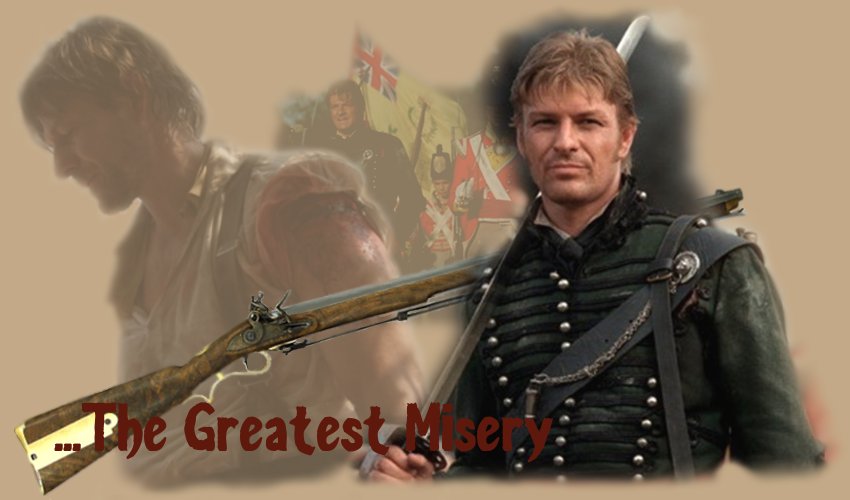

Richard Sharpe began his fighting career in a short, foggy action at Boxtel in Flanders while a common soldier in the King's 33rd Foot under
the command of a youthful Lieutenant Colonel, Sir Arthur Wellesley. The two men's careers would closely parallel each other until the final conflict with Napoleon at Waterloo. He didn't see much of Flanders as he wasn't there long and soon found himself on the battlefields of the Third Maratha War on the northern plains of India. He would experience the slaughter at Seringapatam, Aurungabad, Assaye, Argaum and Gawilghur and return to England via the Battle of Trafalgar as a new Second Lieutenant in the 95th Rifles. Adventure in Denmark would follow before he embarked on the longest campaign of his soldiering days, the Penninsular War.
The Peninsular War was probably the worst mistake Napoleon Bonaparte made during his lengthy reign over France - the attempted subjugation of Portugal in a bid to tighten his trade blockade of Britain. To get at Portugal, Bonaparte had to trick his ally Spain into allowing a French army under General Jean-Andoche Junot to move through its territory. On 1 December 1807, the French captured Lisbon, just missing the royal family who fled to Brazil the day before Junot arrived.
Just three months later, Marshal Joachim Murat took a huge army into Spain on the pretext of restoring order - the king, Charles IV, was quarreling with his son and soon had the entire family taken to France for protection. He later abdicated in favor of his son who became Ferdinand VII who was a hostage under the control of the French.
Bonaparte made the major error of appointing his brother Joseph as the new King of Spain, rubber-stamped by the large party of French-loving reformists, a move that sent the peasantry and the Catholic Church into a rebellious frenzy. Within two months there were open uprisings against Joseph and the conflict descended into one of the most brutal periods of warfare ever seen in Europe. The Spanish artist Goya sketched a series of ink images, Disasters of War, that depict much of the barbarity reached during the campaign.
Despite its shockingly ineffective regular army, the war began well for Spain with the French being forced into a lengthy siege at Saragossa and the French army, under the luckless General Pierre Dupont was forced to surrender at Bailen. The reverses in Spain cut Junot off from any support he might have anticipated, but he felt strong enough to defeat a British army that landed in Portugal on 1 August, 1808. Unfortunately, for Junot and France, the British were led by the "Boy" Wellesley, whose military prowess was fostered in India and was therefore an unrecognized commodity in Europe.
Wellesley beat General Delaborde at Rolica on 17 August and four days later took on a reinforced Junot at Vimiero. The battle ended in victory for the maligned "Sepoy General" Wellesley and with the French on their knees, British idiocy took over when two geriatric generals - Sir Harry "Betty" Burrard and Sir Hew "Dowager" Dalrymple - were placed in command of British forces. The pair negotiated the embarrassing Convention of Cintra with Junot that allowed the trapped French force to withdraw all troops, with all their equipment, on British ships back to France.
Wellesley, Burrard and Dalrymple were all brought before an inquiry where only Wellesley was acquitted of any wrong-doing. In the meantime, Sir John Moore took over the British army and, in expectation of major support from the Spanish, advanced deep into Spain. He was badly let down by the Spanish and found himself without support and up against no lesser opponent than Bonaparte himself.
Fearful of being trapped between no less than three French armies, Moore turned his army around and began a horrendous retreat through winter-blasted mountains that tested the British army to its limits. When faced with destruction, however, the exhausted Redcoats turned on their attackers and saw them off. They won clashes at Sahagun, Benavente and Cacobelos. The city of Corunna was the safehaven for Moore as the Royal Navy was waiting to evacuate his army. While Moore marched for Corunna, General Black Bob Craufurd took the Light Division and the 2 Bn/95th Rifles on towards the port of Vigo, withdrawing in good order under the circumstances, which drew off a good portion of French cavalry from the pursuit of Moore's force. With Marshal Soult now at his heels, Moore arrived at Corunna and organised a defensive perimeter to hold the French at bay while his men embarked.
Corunna was a victory for Britain, but Moore died during the battle, opening the way for the return of Wellesley as commander. With the extremely capable Sir William Beresford retraining and reorganising the Portuguese army, Wellesley at last had allies he could trust and caught Marshal Nicholas Soult unprepared when he crossed the Douro River at Oporto and seized the military initiative.
Moving into Spain, Wellesley was attacked by the French at Talavera, where the duplicitous Spanish general Gregorio de la Cuesta did nothing as the British fought tooth and nail to defeat Marshal Victor and Joseph Bonaparte's army. Deciding against trusting the Spaniards again, the newly-made Lord Wellington of Talavera was forced to fall back into Portugal where he waited for the next opportunity to take on the French.
By 1810, Wellesley had covertly constructed the impenetrable series of defensive fortifications, the Lines of Torres Vedras, which completely cut off Lisbon from attack and stymied the new-appointed Marshal Andre Massena's forces who had high expectations of an easy victory over the Anglo-Portuguese. Massena's invasion of Portugal earned him a bloody nose at Bussaco and before he had time to reorganise for another attempt at Wellington, the British commander had withdrawn behind the defensive perimeter at Torres Vedras. The French Marshal made some vain attempts to get through the lines and then sat obstinately outside them waiting for another chance to be at the British.
Wellington had other ideas and just waited for hunger, the lands having been cleared of foodstuffs and much of the forage-laden lowlands inundated, to take effect. It took the entire winter for Massena to accept defeat and he was finally forced to march his starving army towards more fruitful territory. The British won a further battle at Barrossa as Massena retreated followed by an encounter at Fuentes de Onoro which ended indecisively, with both British and French forces near equally bloodied.
In 1811, one of the most bloody encounters on the Peninsula occurred when Soult moved to relieve the siege of Badajoz, a fortress guarding the Portuguese-Spanish border. Marching towards the city, he attacked a blocking force under Beresford at Albuera. The battle was up-close and nasty with the two lines of troops separated by a mere 20 paces. In the end it was the obstinacy of the British that won them the battle. Soult later remarked that the Redcoats just didn't understand when they were beaten.
While Wellington's army was the master of the countryside, the French still garrisoned the key fortresses of Badajoz and Ciudad Rodrigo. The mighty towns stood as gatekeepers into Spain and the British leader knew he had to capture them before taking on the French in Spain. As careful of his mens' lives as he was, Wellington lost caution when storming the fortresses and both Ciudad Rodrigo (19 January) and Badajoz (19 April) were extremely bloody affairs that cost thousands of British lives and then thousands more French and Spanish lives inside the cities as the Redcoats were given free reign. The sacking of both fortress cities brought little honour to Britain.
Moving quickly into Spain, Wellington found himself up against a new French commander, Marshal Auguste Marmont. He dealt with him the same way as the others and defeated him soundly at Salamanca, shortly after freeing Madrid. Unable to capture the fortress at Burgos, the British had to make another retreat to safety in Portugal as another fierce Penninsula Winter set in, but not before the back of French occupation was broken at the battle of Vitoria where King Joseph not only lost his crown and his royal piss pot, but also millions of pounds worth of treasure.
Soult now took over command of a unified French force and conducted a brilliant series of rearguard battles through the Pyrenees.
By early Spring, Wellington forced his way through, bursting through the mountain passes and overran the border fortresses, defeating Soult at Orthez and then, finally, at Toulouse. The Peninsular War was finally over and Sharpe took a well-earned rest in Normandy, until that is, Napoleon Bonaparte decided he didn't particularly care for his forced exile on Elba. Sharpe and Harper marched off to war once again for the Hundred Days War that finally saw the end of Napoleon's vision of a French Republican Empire in Europe.
With 21 books in the Sharpe series, Bernard Cornwell has built a number of them
around one or more of the actions that the British Army was involved in. He
has said in interviews that he isn't quite finished with Richard Sharpe yet.
As such, many of the actions found in this directory have never been included
in any of the current Sharpe novels. Will he witness any of them in future volumes?
Only Bernard Cornwell knows for certain, and he's not telling.


 |
Wellesley ordered his army's offensive deployment to commence against Scindia on 6 Aug, 1803. Siege planning had been completed and Wellesley and his force arrived at Ahmadnagar on 8 Aug, just as a letter requesting surrender was delivered to the fort. The proposal was refused as was a subsequent offer of protection to the pettah outside the fortress, if it were to accept occupation.
Wellesley set his plan in motion with an initial attack on the pettah, to cover the second stage of the attach, that on the actual fort itself. The story of the brief struggle for the pettah is often accompanied by a quotation attributed to Maratha General Gokale: "These English are a strange people, and their General a wonderful man: they came here in the morning, looked at the Pettah wall, walked over it, killed all the garrison and returned to breakfast! What can withstand them?"
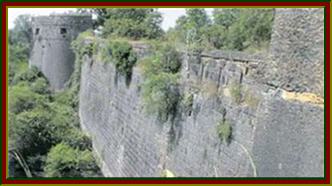
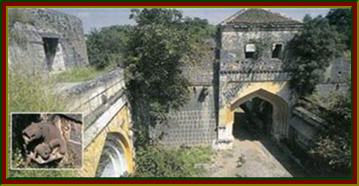
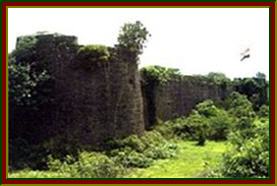
Although the facts are disputed, the fort was taken by escalade, even after it was discovered that there was no firestep or rampart inside the pettah wall and once inside, British soldiers had a straight drop down the other side. Artillery fire support was required to support the assault. Wellesley finally took the fort and city with a loss of nearly a fifth of his force after tough urban hand-to-hand fighting. After sacking the city and garrisoning the fort with loyal troops, Wellesley crossed the Godavary River and headed north towards Auringabad, but not before restoring the damaged walls and building a glacis to fortify the existing defenses.
The combat of Albergaria Nova of 10 May 1809 was the result of an unsuccessful British attempt to trap the advance guard of Marshal Soult's army at Oporto at the start of Sir Arthur Wellesley's campaign in Northern Portugal of 1809.
Having occupied Oporto on 29 March 1809, Soult had posted Franceschi's cavalry division and Mermet's infantry divison between Oporto and the River Vouga thirty miles to the south. By early May those forces were strung out along the main road from Oporto to Coimbra. An advance guard of 1,200 cavalry, 700 infantry and one light gun battery was placed at Albergaria Nova, three miles north of the Vouga. Mermet's 3,500 strong division was split between Feira, fifteen miles to the north (4 battalions of the 31st Léger) and Grijon (7 battalions), five miles further north.
Wellesley hoped to surprise Franceschi's advanced guard and trap them between two forces. The main British force, five infantry brigades and the cavalry, would make a frontal assault on the French position, while Hill's and Cameron's brigades were to sail up the coast to Ovar, and then march inland to block Franceschi's retreat.
The plan failed for two reasons. For it to success, Wellesley had to attack the French before they realised he was close, but Soult had been received advance warning of the British attack from a very unexpected source on 8 May. Napoleon was not universally popular in the French Army, for a small core of officers believed that he had betrayed the revolution. When Wellesley arrived in Portugal he found that negotiations had been going on between his predecessor and a Captain Argenton. Wellesley met the French plotter, but was not impressed and had no interest in supporting his plans. Argenton returned to his lines, where he was arrested. On 8 May he was interrogated by Soult, and in an attempt to convince him to chance sides warned him that Wellesley was on his way. As a result of this when the British advance guard found Franceschi's force on 10 May there was no longer any chance of surprising them.
The second reason for the failure of Wellesley's plan was that it required a night march across unfamiliar country. The plan was for five squadrons of cavalry under General Cotton and the infantry brigades of Murray and Richard Stewart to attack together, drive in the French pickets and attack Franceschi's main force before they could prepare for battle. If they tried to retreat, Hill and Cameron would be blocking the road north.
Cotton, Murray and Richard Stewart all found that the night march took longer than expected. Cotton's cavalry finally attacked the French pickets at 5 am, but then discovered the rest of Franceschi's force drawn up in line of battle behind Albergaria Nova. Cotton was outnumbered nearly two-to-one, and decided not to risk a clash with the French until the infantry arrived. That wasted much of the morning, for the first three battalions of infantry were some hours behind Cotton's infantry. When they did finally arrive, Franceschi abandoned his position and retreated back to Grijon to join with Mermet. The only real fighting of the entire day followed, as the British 16th Light Dragoons attacked the French 1st Hussars, who had been left as a rearguard, and forced them to retreat.
If things had gone to plan, the retreating French should have run into Hill's infantry blocking the road north, but their amphibious flanking manoeuvre had fizzled out during the morning. They had reached Ovar according to plan, but then had discovered that there was a force of French infantry close by at Feire, and no sign of the British advancing from the south. Hill decided to wait in Ovar while Cameron's men were shipped up the coast. At noon, three battalions of French infantry arrived from Feire. Hill himself only had three battalions and a company of the rifles, and so was unable to make any progress. The situation only changed when Franceschi's men began to stream past, with the British cavalry in pursuit. At that point Hill attacked the skirmishes facing him at Ovar and forced them into a retreat.
At the end of the day the French advance guard had taken up a new position at Grijon, where on 11 May they would fight a more serious rearguard action.
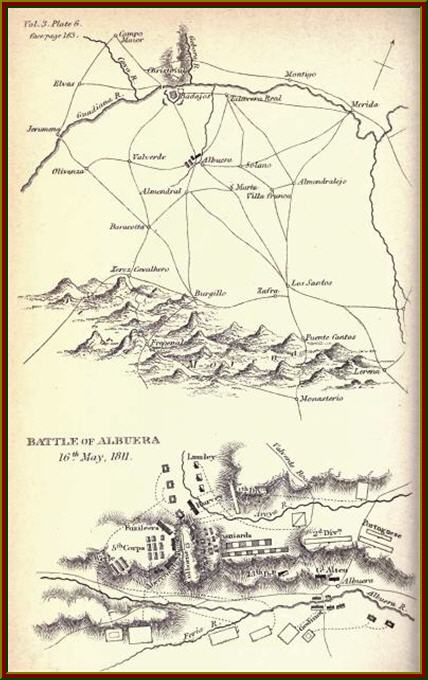 In a brutal,
in-your-face battle where pure courage won the day for the British, a force
under Marshal Beresford had moved south away from Badajoz to fend off Marshal
Soult's attempt to relieve the first siege of that frontier fortress.
In a brutal,
in-your-face battle where pure courage won the day for the British, a force
under Marshal Beresford had moved south away from Badajoz to fend off Marshal
Soult's attempt to relieve the first siege of that frontier fortress.
Taking up positions at Albuera with some 35,000 men, made up of British, Portuguese
and Spanish troops, Beresford readied himself for Soult's 24,000 troops. In
a superb flanking manouevre, the French marshal attacked the Allies right wing,
brushing aside Spanish units and got ready to roll up the defenders' line.
Many of General Joachim Blake's Spaniards fought bravely against great odds
and a British counterattack failed with massive casualties - the result of a
blinding downpour that hid the proximity of Polish lancers until it was too
late. One British brigade suffered 80% casualties.
A second French attack almost succeeded, due to General d'Espana's refusal to
reinforce the line and poor communication high in the British command. A decision
by General Lowry Cole to hit the French column on its flank turned the battle,
but it was still desperate times.
For much of the firefight British and French troops were within 20 paces of
each other. After four hours of bitter fighting the French broke before a British
charge and the day was won. Marshal Beresford was severely criticised for his
leadership during the battle, but was backed up by the Duke of Wellington.
Combat of Aldea de Ponte
27 September 1811
The combat of Aldea de Ponte of 27 September 1811 was a rearguard action fought during Wellington's retreat from Fuente Guinaldo to Alfayates in the aftermath of the combat of El Boden. In August-September 1811 Wellington had been blockading Ciudad Rodrigo, but in late September Marshal Marmont had raised the blockade at the head of an army 58,000 strong. Most unusually Wellington had left his army rather dangerously stretched to the south and west of Ciudad Rodrigo while Marmont approached, and on 25 September had nearly paid for that mistake when a strong French cavalry force had come close to cutting Wellington's 3rd Division in half close to El Boden.
After some hard fighting the 3rd Division had escaped, but Wellington was still not out of danger. He had prepared two strong positions where he would have been willing to fight a defensive battle, one at Fuente Guinaldo, south of Ciudad Rodrigo, and one at Alfayates (or Alfaiates), thirteen miles to the west, just across the Portuguese border.
At the end of 25 September Wellington had the 3rd and 4th Divisions with him at Fuente Guinaldo, along with Pack's Portuguese brigade and part of his cavalry, giving him a total of 15,000 men. The Light Division was close by to the east, although would not reach the camp until the afternoon of 26 September, but the 1st and 6th Divisions had been posted along the Azava (or Azaba) river, to the west of Ciudad Rodrigo, and it soon became clear that they would not be able to reach Fuente Guinaldo.
Although Marmont had made no use of his infantry on 25 September, by the end of the day he had 20,000 infantry facing Wellington, and by noon on 26 September the entire French army was concentrated to the north of Fuente Guinaldo. If Wellington had been able to concentrate his entire army at that position, then he would have been willing to risk a battle, but throughout 26 September he was in a very vulnerable position.
Luckily for Wellington, Marmont decided not to attack. His reasoning was entirely logical - the French believed that in the past Wellington had not been willing to risk a battle unless he had a strong army in a strong position (they habitually overestimated the amount of men Wellington had at his disposal during his battles) - and so if Wellington was happy to spend all day in his position at Fuente Guinaldo then he must have enough men to defend it.
That night both armies began to retreat, Wellington west to his next position at Alfayates, and Marmont back to Ciudad Rodrigo. When Marmont's rearguard reported that the British were on the move, he ordered his army to turn around and follow Wellington. The French pursuit was too distant and too weak to worry Wellington, and by the end of 27 September he was secure in his new position.
The only fighting came at Aldea da Ponte, a village to the north east of Alfayates where several roads met. This position was defended by the pickets of the 4th Division and Slade's dragoons. Although it was not part of his main position, Wellington decided to defend Aldea da Ponte against any minor attack, and only abandon it if the French attacked in force.
The first French troops to reach Aldea da Ponte were Wathier's cavalry. They were soon joined by Thiébault's infantry division. At this point the village was defended by the light companies of the Fusilier brigade. Thiébault decided to send the three battalions of the 34th Léger to capture the village. One battalion attacked the village, while the other two outflanked the position, and the light companies were forced to retreat.
Wellington responded by sending the entire Fusilier brigade, supported by a Portuguese regiment, to recapture the village. The French battalion in the village was forced to retreat, and fusiliers took possession of the village.
This position lasted only lasted until dusk. Thiébault had been joined by Montbrun's cavalry and Souham's division. This time it was Souham who attacked the village, and once again the British were forced to retreat. With darkness approaching, and aware that the village was not part of his main defensive position, Wellington decided not to attempt to take it back.
The British and Portuguese suffered 100 casualties during this combat (71 in the Fusiliers, 13 in the Portuguese regiment and 10 in Slade's cavalry), while the French lost around 150 men.
Wellington was now in a very strong position, with both of his flanks protected by the River Coa and a front line said to be as strong as that defended at Bussaco. After examining this position on 28 September Marmont rather sensibly decided not to attack, and pulled back to Ciudad Rodrigo. On 1 October the French army was broken up and sent into its winter cantonments, and the danger to Wellington's army was over.
French Siege of Almeida
25 July-27 August 1810 (Sharpe's Gold)
The siege of Almeida of 25 July-27 August 1810 was a delaying action fought to slow down Marshal Masséna's invasion of Portugal in 1810, most famous for the dramatic explosion that ended the siege.
Almeida was the main Portuguese fortress on the northern invasion route from Spain, matching the Spanish fortress of Ciudad Rodrigo. In 1810 it was a well designed modern fortress, almost perfectly circular and protected by six bastions, a dry ditch and bombproof casements, was armed with 100 guns and was garrisoned by 4,000 infantry, 400 gunners and one squadron of cavalry, all under the command of William Cox, a colonel in the British army and a brigadier in the Portuguese. Wellington had made sure that the place was well stocked with food and ammunition. The hope was that Almeida would hold out for long enough to prevent the French from advancing into Portugal during the summer of 1810.
Despite its dramatic ending the siege actually satisfied this expectation. The last Allied troops in touch with Almeida, Craufurd's Light Division, were driven away on 25 July (Combat of the Coa), and Ney's 6th Corps began the blockade of Almeida. The siege itself did not begin for two more weeks, as it took some time for the heavy siege train to travel from Ciudad Rodrigo, and work did not start on the siege works until 15 August.
By the morning of 26 August the French had completed eleven batteries, and at six in the morning they opened fire. The town was soon on fire, and in three of the bastions the Portuguese gunners were pinned down, unable to return fire, but the walls were still intact.
That evening a chance event ended any realistic prospects of prolonging the siege. The main powder magazine was in the elderly castle of Almeida. At about seven in the evening the main door to the magazine was open and a powder convoy was leaving to resupply the guns on the southern walls. According to the only survivor of the disaster, a French shell landed in the castle courtyard and ignited a trail of powder that led from a leaking barrel back into the magazine. A second barrel, just inside the door exploded, and this blast ignited the main powder store. The massive explosion destroyed the castle, the cathedral and removed the roofs from all but five houses in the town. Over 500 members of the garrison were killed, amongst them half of the gunners. Some of the stones were flown so far that they killed men in the French trenches.
The defence was effectively over. The only way to move around the town was on the ramparts, for the interior was completely blocked with ruins. Only 39 barrels of powder and a few hundred rounds that had already been moved to the walls survived the explosion, just enough for one day's fighting but no more.
Cox was determined to fight on, at least for long enough to give Wellington a chance to rescue the garrison. This was always going to be a forlorn hope, for Wellington had never had any intention to attack Masséna's army on the Portuguese border - the risk was simply too great. Unsurprisingly the explosion had totally demoralised the Portuguese garrison of the town, especially some of the officers. Although Cox attempted to bluff the French, holding a conference with French officers in a closed casement to hide the damage, some of the Portuguese officers told the French exactly what had happened. When Cox sent Major Barreiros of the Artillery to negotiate with the French, he changes sides and told Masséna that there would be no further resistance.
Reassured by this, Masséna turned down all of Cox's requests for delays, and at seven in the evening of 27 August renewed the bombardment. A delegation of Portuguese officers then informed Cox that if he did not surrender, they would open the gates. Cox had no choice but to capitulate. On the next morning the 4,000 survivors of the garrison marched out of the town. Under the terms of the surrender Masséna had agreed to allow the militia to go home on parole while the regulars were to be taken back to France as prisoners. Masséna broke this agreement with breathtaking speed, and instead attempted to recruit the Portuguese prisoners into his own army.
Most of the surviving regulars and 600 of the militia immediately enlisted with the French, giving Wellington a real scare. If he could not rely on the Portuguese, then his entire plan of campaign was in danger. He need not have worried. Over the next few days most of the three battalions Masséna thought he had recruited absconded, often in large parties, and made their way back to the Allied lines. At first Wellington was worried about employing officers who had theoretically broken their parole, but the Portuguese government had no such concerns, and as Masséna had broken his word first Wellington's concerns were short-lived.
British Siege of Almeida
April-10 May 1811
The siege of Almeida of April-10 May 1811 saw Wellington's army capture the last French stronghold left in Portugal after Marshal Masséna's retreat from the Lines of Torres Vedras. Almeida had been captured early in Masséna's invasion of Portugal in 1810, and the area had been occupied by General Drouet's 9th Corps. As Masséna retreated past Almeida towards Ciudad Rodrigo, Drouet was forced to abandon his own advanced position. Not knowing this, on 7 April Wellington sent Trant's militia and Slade's cavalry brigade towards Almeida, in an attempt to force Drouet to retreat. One of Drouet's two divisions had already left, but close to Almeida they found Claparéde's division, and a brief skirmish followed which saw the French retreat towards the Agueda River in battalion squares.
Wellington did not have a siege train with his army, and so he had to settle down to starve out the small French garrison of Almeida. Most of his army was posted between Almeida and Ciudad Rodrigo, while the 6th Division and Pack's Portuguese brigade carried out the actual blockade. The French garrison was tiny - General Brennier had just over 1,300 men in the town, formed from one battalion of the 82nd Line and a provisional battalion of artillery and sappers. They had enough food to last a month, despite Masséna's men having taken 200,000 rations from the town as they passed.
The only way Brennier could hope to hold Almeida was if Masséna successfully broke the British blockade. At first Wellington dismissed this possibility, believing that the French Army of Portugal had been too badly disordered during its retreat to make any serious move forwards, but he was mistaken. Masséna was determined to retain possession of the fortress, and by the end of April had gathered together a strong relief force. This army advanced west from Ciudad Rodrigo, before being defeated by Wellington at Fuentes de Oñoro (3-5 May 1811).
After this defeat, Masséna abandoned any hope of relieving Almeida and instead decided to order Brennier to break out from the town. Three volunteers attempted to take this order into the town, and although two were caught and executed as spies, the third managed to get into the town. Brennier was ordered to break out to the north, where the Allied lines appeared to be thinnest. On the night of 7 May Brennier fired three heavy salvoes at five minute intervals to signal that he had received the order and on the following day Masséna began his retreat.
Even during the battle Almeida had still been blockaded by Pack's Portuguese brigade and the 2nd Regiment from the 6th Division, but once it was clear that Masséna was not going to attack again Wellington posted three brigades outside the town. If these men had been keeping a close watch on the town then the breakout would have been impossible, but General Campbell posted his men too far from the walls, and then failed to post pickets close to the walls.
During 8-9 May Brennier planted mines in the defences of Almeida, and spiked his guns. At 11.30pm on the night of 10 May he made his move. Forming his men into two columns, Brennier struck the Allied lines at the junction between the 1st Portuguese Regiment of Pack's Brigade and the 2nd Queen's Regiment of Burne's division, and easily broke through the Allied cordon. Five minutes later the mines in Almeida exploded, destroying much of the eastern and northern fortifications, and rendering the town useless to Wellington for some time. While the Allied troops outside Almeida attempted to discover what was going on, Brennier's men made their way towards the crucial bridge at Barba del Puerco.
Earlier in the day Wellington had decided to extend his lines to include this bridge, and had ordered General Erskine to move the 4th Regiment of the 4th Division to guard the bridge. It appears that Erskine failed to pass on this order until late in the day, and so the bridge was unguarded. The 4th Regiment did eventually catch up with Brennier while the French were crossing the bridge, as did the 36th Regiment, and the French suffered heavy casualties attempting to reach the bridge, but 940 of Brennier's 1,300 men made it to safety. Brennier himself was promoted to general of division for his achievement. On the British side Colonal Bevan of the 4th Regiment was blamed for the failure to block the bridge, and committed suicide rather than face a court of inquiry. Almeida itself was now useless to the Allies, although it was also denied to the French, who now had nothing to show for their massive invasion of Portugal in 1810.
Passage of the Alva River
17-18 March 1811
The passage of the Alva River of 17-18 March 1811 was a nearly bloodless success for Wellington's army during the French retreat from Portugal in the spring of 1811. On 16 March the French had abandoned their position on the Ceira River at Foz de Arouce, and retreated towards the Alva. Once there they discovered that the bridge at Ponte de Murcella had been destroyed by the Portuguese and were forced to spend the rest of the day repairing it, all the time expecting Wellington's advance guards to appear.
In fact Wellington had chosen to spend 16 March resting, partly in order to give a supply convoy time to reach his army. This gave Masséna enough time to get his army across the Alva, and to take up strong defensive positions on the north bank. The 2nd Corps was sent east, to defend the ford at Sarzedo, placing a detachment at Arganil on the south bank of the river. The 6th and 8th Corps remained around Ponte de Murcella, guarding the fords across the river.
The line of the Alva was a strong defensive position. During Masséna's advance into Portugal in 1810 Wellington had intended to defend, but to his surprise the French had chosen a more northerly road, crossing the ridge at Bussaco.
Now he was faced with the same defensive position, Wellington had no intention of launching a frontal assault against the strong French positions. Instead, the 1st, 3rd and 5th Divisions and the Portuguese brigades were all sent along the mountain road from Furcado to Arganil, while only two divisions were sent towards Ponte de Murcella. These last two divisions remained hidden from Ney, who could only see cavalry on the southern bank of the Alva.
During the afternoon of 17 March the main British column reached Arganil, driving out the detachment from Reynier's 2nd Corps. At this point no infantry had been seen at Ponte de Murcella, and Masséna was convinced that the British intended to either attack at Sarzedo, or to move even further east, cross the river beyond the French left, and attempt to block their line of retreat. Accordingly he ordered Junot's 8th Corps to leave its camps on the French right and move to Galiges, to the east of Sarzedo, to extend the French left.
Wellington's plan was actually rather less ambitious than Masséna believed. On the morning of 18 March the Guard's Brigade of the 1st Division left the road from Furcado to Arganil, and forced their way across the Alva at Pombeiro, between Ney's position at Ponte de Murcella and the rest of the French army. Realizing that he was in real danger of being trapped between the two wings of Wellington's army, Ney abandoned his position with great speed, and managed to elude Wellington's trap. Despite this, the British and Portuguese had forced the French out of a potentially very strong position with very little lose. The French were forced into a lengthy night march which saw the British capture 600 prisoners.
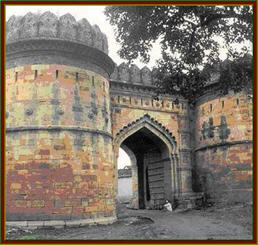
The Battle of Argaum took place on November 28, 1803, between the British under
the command of General Arthur Wellesley and the forces of The Rajah of Berar
under Scindia of Gwalior. Three of Wellesley's battalions, which had previously
fought well, on this occasion broke and fled, and the situation was at one time
very serious. Wellesley, however, succeeded in rallying them, and in the end
defeated the Marathas, with the loss of all their guns and baggage. The British
lost 346 killed or wounded.
The Rajah of Berar was a leader in the Maratha Empire, also known as the Maratha
Confederacy durind the Second Anglo-Maratha War. The Sindhia, also spelled Scindia, Sindia, or Shinde are a prominent Maratha family in India.
The combat of Arzobispo of 8 August 1809 was a minor French victory late in the Talavera campaign, which saw them force their way across the River Tagus. After their success at Talavera, the British and Spanish had been forced to retreat by the unexpected arrival of three French corps from the north west of Spain under Marshal Soult. The British slipped across the Tagus at Arzobispo on 4 August, and despite some delays the Spanish followed on the night of 5-6 August.
The Allied armies then moved west along the south bank of the Tagus, heading for the main road into Estremadura, leaving a strong rearguard to protect the river crossing. In total the Spanish left 8,000 men to guard the bridge (5,000 infantry and 3,000 cavalry), under the overall command of the Duke of Albuquerque. They had two crossing to protect - the bridge at Arzobispo and a nearby ford at Azutan. The bridge itself was strongly held, with a detachment of infantry defending the medieval towers in the middle of the bridge and gun emplacements covering the approaches to the bridge, but the Spanish somewhat overestimated the difficult of the ford.
After spending 7 August investing the river, Soult's men discovered that the deep channel in the river was close to the north bank, and after that the river was only two or three feet deep. Once the French cavalry was past this deep channel, it could fan out to attack any part of the opposite bank. Their chance of success was greatly increased by Albuquerque's deployment - most of his men were held back from the river, with only one cavalry regiment watching the ford, and two infantry battalions at the bridge.
Soult launched his attack at 1.30pm, during the siesta. He sent his entire force of 4,000 cavalry to attack across the ford, supported by one brigade of infantry. A second infantry brigade was to watch the bridge, but was only to attack once the French had crossed the ford. Caulaincourt's brigade of dragoons, 600 strong, led the attack, and quickly swept away the Spanish cavalry. The Spanish responded by sending one battalion of infantry from the bridge, but it failed to form square in time and was cut up by the French cavalry. Over the next half hour the French were able to pass the rest of their cavalry across the ford.
This was the signal for the start of the attack on the bridge. Despite their strong position, the Spanish defenders of the bridge could see that their line of retreat was about to be blocked, and so after firing a couple of volleys fled east, away from the rest of Albuquerque's force. Only now did the rest of the Spanish force come into action. While the remaining infantry formed up on a hill above the bridge, Albuquerque led his 2,500 cavalry in a desperate charge against the leading French cavalry. Having wasted a crucial half an hour while the French were crossing the ford, the Spanish attack was carried out before the cavalry had a chance to form up properly, and was quickly repulsed by the more organised French. Seeing the cavalry defeated, the infantry abandoned their position, and retreated across the hills to safety.
The Spanish cavalry suffered heavily in the battle at the ford, losing 800 killed and wounded and 600 prisoners, leaving only 1,100 of the original 2,500 men still with the colours. The French captured 16 Spanish guns at the bridge, and fourteen of the guns they had lost at Talavera. Despite their success, the French crossed the Tagus too late to have any chance of catching the main Allied army. An attempt to cross the river further west, at Almaraz, failed after Ney's men could not find the fords they had been sent to cross. The British and Spanish took up a strong defensive position around Almaraz. Even Soult realised that this position was too strong to be assaulted, and proposed invading Portugal from Ciudad Rodrigo, but King Joseph opposed this plan. Instead the armies that had threatened Wellington were dispersed to deal with other threats.
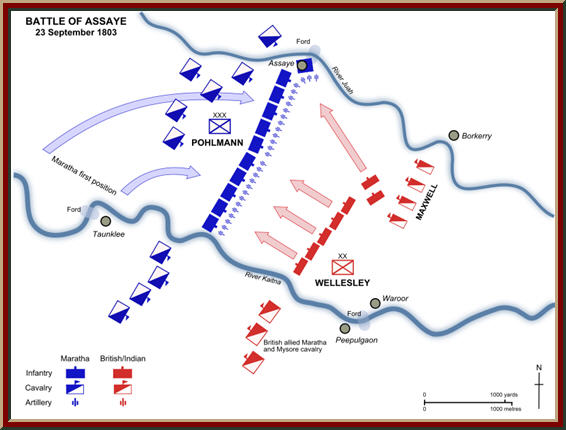
In charge of a British and sepoy army of some 13,500 men, General Arthur Wellesley took on a major Indian force at least three times the size of his own at Assaye.
The army of the princes of Scindia and Berar was drawn up between the Kaitna and Juah rivers - a position the leaders thought would force the British to attack them across the Kaitna.
Wellesley, however, found a nearby ford and crossed the river near the village of Assaye and moved against the enemy's left flank. The move was not without its dangers and only a strong counterattack by the British cavalry forced the elite Mahratta cavalry away. The well-trained Scindian infantry repositioned themselves quickly to cover the new threat and expert handling by a German soldier of fortune called Pohlman allowed the artillery to do likewise.
Against fierce resistance and with growing numbers of casualties, Wellesley led his men on, captured the enemy cannons and pushed the Scindian troops backwards.
The village of Assaye itself was a tough defensive nut to crack and, adding to Wellesley's difficulties, another Mahratta cavalry attack had to be seen off by the British cavalry. With the enemy horse dealt with, the British then turned their attention to the infantry and scattered several columns.
Wellesley now launched a major assault and broke the Scindians, who found themselves with their backs to the Juah river. By early evening, the princes were in retreat and left behind some 6000 casualties. The British had suffered 1600 killed and wounded.
 |
Badajoz
16 March, 1812 (Sharpe's Company)
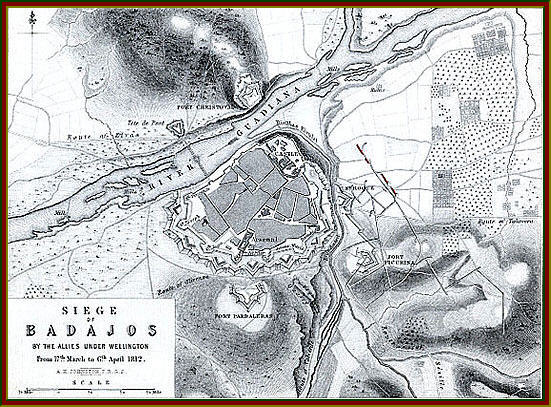
More than 30,000 British troops blockaded the fortress at Badajoz, which commanded the southern route between Spain and Portugal. The siege commenced and by 6 April the 5000 defenders were steeling themselves to be attacked through three breaches.
The night assaults began bloodily against the formidable defences and more than 40 times did the redcoats throw themselves into attack. By midnight, two entries to the city had been forced and an hour later the defenders under General Phillipon holed up in Fort San Christobal and accepted terms later that day.
The city was sacked furiously by the hard-pressed British troops. French losses were almost 1500 men, while some 3500 British troops became casualties.
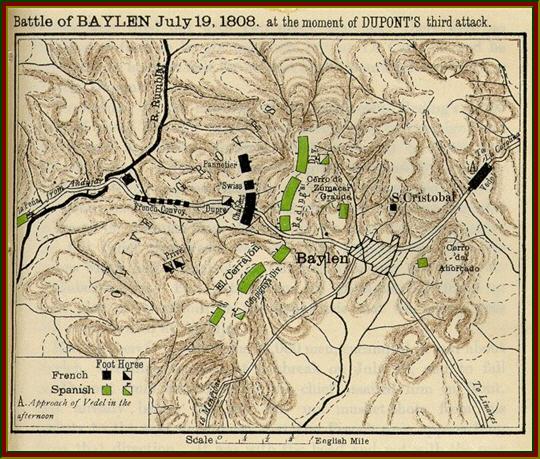
By 1808, thousands of French troops were present in Spain in support of Napoleon's invasion of Portugal. In April, Napoleon deposed the Spanish king, Charles IV, replacing him with his own brother Joseph. The Spanish army and people revolted (the Dos de Mayo Uprising) against the imposition of foreign rule.
With much of Spain in open revolt, General Dupont received an order to capture the city of Cádiz, where Admiral François Rosilly's fleet lay at anchor. Dupont's corps numbered 15,000 inexperienced and largely new recruits, grouped in three infantry divisions under Vedel, Barbour, and Gobert, and a cavalry division under General Fresii.
Dupont approached Cordoba in early June, forcing the Alcolea bridge, where Spanish militia under Colonel Echeveria attempted a stand on 6 June. The French entered Cordoba the next day and ransacked the town for four days. However, in the face of increasingly menacing mass uprisings across Andalusia, Dupont decided to withdraw to Sierra Morena, hoping for help from Madrid. General Gobert's division set out from Madrid with General Savary on 2 July, aiming to succour Dupont's beleaguered forces. However, only one brigade of his division ultimately reached Dupont, the rest being needed to hold the road north against the guerrillas.
The French retreated fitfully in the sweltering heat, impeded by 500 wagons of loot and 1,200 sick. General Vedel, likewise, withdrew from Toledo on 15 July, bringing 5,000 infantry, 450 cavalry and 10 cannons. On 18 July Dupont unwisely opted to linger at Andujar, setting up camp on the plains while Spanish troops marched to bar the road to the mountains. Under Dupont's orders, Vedel moved north to dislodge the militia holding the pass at Despeñaperros, opening an ominous gap between the French divisions. Garrisoning the pass with a battalion of infantry, Vedel turned to rejoin Dupont with the rest of his forces. But, Castaños seized the central position, placing 17,000 men and 12 guns between Dupont and Vedel.
After joining formations, Dupont's forces were divided into three groups: General Gobert's division in the village of La Carolina, General Vedel's division in Bailén and General Dupont and his forces occupied Andujar. Meanwhile, the Spanish Army, commanded by General Castaños, had more than 33,000 soldiers. He had under his command some regular regiments from Seville (also one from Switzerland) and formations of provincial militia and peasants. The size of Castaños' army far outweighed that of Dupont. When Dupont received information about Castaños's arrival, he ordered Vedel to join him in Andujar. After Vedel left Bailén, Spanish forces, commanded by General Reding, captured the town and successfully defended it against Corbert's brigade. During the attempt to recapture the town, General Corbert was killed and his brigade withdrew to La Carolina. After learning this, Dupont ordered Vedel to recapture the town; he succeeded, but afterwards he left the town to take up positions in Bailén.
Reding overtook the French along the banks of the Rumbla and crashed his division against the French rearguard, inflicting serious losses. The Swiss soldiers in Spanish employ advanced. Dupont called Vedel for help, but after the arrival of Castaños he decided to sign a truce. After learning this, Vedel withdrew to the mountains. Spanish commanders threatened to massacre the French soldiers if they didn't surrender.
On 22 July, the French II Corps of Observation, under Gironda, surrendered. Dupont and his soldiers were transported on English ships to Rochefort harbour because the Spanish junta in Seville didn't recognise the pact under which they were sent to Cadiz. Except for Dupont and his staff officers, they were placed on prison-ships converted for the purpose. Only a small number of the French soldiers survived to 1814.
Following their defeat, the remainder of the French army left Madrid under the command of Marshals Bessieres and Moncey. When they reached the Ebro river they set up new defensive positions. The Spanish victory at Bailén signalled to the armies of Europe that the French were not invincible - a fact that persuaded the Austrians to wage a new war against Napoleon.
Barba del Puerco
19-20 March 1810
The skirmish of Barba del Puerco of 19-20 March 1810 was a minor clash between part of Craufurd's line of outposts on the Portuguese border and part of the French army gathering in preparation for Massena's invasion of Portugal. In the spring of 1810 Craufurd's Light Division was watching the line of the Agueda River. Most of his infantry was pulled back from the river, but four companies of Beckwith's 95th Rifles were close to the river, watching the bridge of Barba del Puerco (north west of Ciudad Rodrigo). This was a strong position in a difficult pass, and Craufurd felt that the rifles would be able to hold off any force small enough to surprise them.
This was put to the test on the night of 19-20 March. Loison's division had taken up a position facing the northern stretch of the Agueda, with Ferey's brigade at San Felices. Ferey decided to make an attempt to capture the pass of Barba del Puerco by surprise. He gathered the six voltigeur companies of his brigade, and before dawn on 20 March surprised the sentries of the bridge, who were bayoneted before they could raise the alarm.
The French then began to climb up out of the river valley towards the village, but not without being detected. Craufurd's men took pride in the speed with which they could come to arms, and within ten minutes of the alarm being raised three companies of the 95th Rifles were in place to attack the French. Ferey's men were driven back across the bridge, losing two officers and forty five men during the fighting. Beckwith's rifles suffered four dead and ten wounded during the clash. For the next few days Craufurd was on alert, expecting a general French advance, but nothing happened until later April, when the French finally moved up towards Ciudad Rodrigo.
The combat of Barquilla of 10 July 1810 was one of the few failures for General Craufurd and the Light Division during Marshal Masséne's invasion of Portugal. Since the start of 1810 Craufurd had been watching the French along the line of the Agueda River. During the French siege of Ciudad Rodrigo (5 June-10 July 1810) he had been pushed back to Fort Concepcion, close to Almeida, but was still keeping an active watch on the French.
On 10 July Craufurd decided to attack some of the French foragers who were attempting to find food between the Azava and Dos Casas Rivers. Taking six squadrons of cavalry, six companies from the Rifles and the 43rd Foot, one battalion of Portuguese light infantry (the Caçadores) and two guns, he soon found a small party of French troops close to the village of Barquilla.
This French force was very badly outnumbered, and consisted of two troops of cavalry and 200 men from the 22nd Regiment of Junot's corps. As the British approached, the French began to retreat back towards their main lines. Craufurd ordered one squadron from the German Hussars and one from the 16th to attack the retreating French infantry.
The French responded by forming a small square. As nearly always happened, the cavalry were unable to break into this square, despite its small size. The first two squadrons failed to even attack the square, instead charging around its sides before heading off the chase the French cavalry. Craufurd then sent a squadron from the 14th Light Dragoons to attack the French square. This time the British cavalry closed with the French, but were repulsed by close-range musket fire. The colonel of the 14th and seven of his men were killed. Before Craufurd could bring up his next squadron, the French managed to escape into the next village. By now the first two cavalry squadrons were returning from their charge, and it is said that the British mistakenly believed them to be French cavalry.
Although Craufurd's men took 31 prisoners, they lost nine dead and twenty three wounded. Craufurd was much criticized for failing to bring his infantry up in time, and for allowing a smaller French force to escape from him, while the commander of the French square (Captain Gouache) was promoted and decorated for his skilful handling of affair.
Barrosa
5 March, 1811 (Sharpe's Fury)
 During his
blockade of the southern port of Cadiz, Marshal Victor heard of a combined British
and Spanish force moving to attack him in the rear. Splitting his force, he
moved the bulk - some 7000 men - against the enemy moving from the direction
of their landing point at Tarifa, between Cape Trafalgar and Gibraltar.
During his
blockade of the southern port of Cadiz, Marshal Victor heard of a combined British
and Spanish force moving to attack him in the rear. Splitting his force, he
moved the bulk - some 7000 men - against the enemy moving from the direction
of their landing point at Tarifa, between Cape Trafalgar and Gibraltar.
While they outnumbered Victor's troops by three-to-one, the Anglo-Spanish force
only had just over 5000 British troops under the command of Sir Thomas Graham.
The Spanish were led by the Count de la Pena and cooperation between the two
allies was poor to say the least. Their objective was actually to relieve the seige of Cadiz.
Despite having just completed 14 hours of marching, La Pena moved forward with the Spanish contingent on the 5th and successfully broke the French siege lines at Bermeja, forcing a French division under Gen. Villate back across the Almazna creek. At mid-day, the British contingent stationed on Barrosa Hill marched off to join La Pena, leaving behind several Spanish regiments and none other than Browne's Flank Battalion, containing the 2 companies of the 82nd. Half and hour later, with their artillery stuck in boggy ground, the French launched an infantry
assault and began a bloody exchange with Graham's men, a small blocking detachment, which was attacked by a good part of an entire French Division under Gen. Ruffin. The Spanish soldiers flew in a panic, making away with the baggage, while Browne's Battalion hastily beat to arms and retired in better order. Graham, now notified, ordered Brown to stand fast and fight, while the main British force marched to join them. This the battalion did, against fearful odds.
An account of the battle describes the action:
"Against the slender force Marshal Victor directed an overwhelming attack, and Browne retreated in good order. Then he sent for orders from Graham, who was then near Bermeja. 'Fight' was the laconic answer; and Graham, facing about himself, regained the open plain… when the view opened, he beheld Ruffin's brigade, flanked by the two grenadier battalions, near the summit on the one side, the Spanish rearguard and the baggage flying towards the sea on the other, the French cavalry following the fugitives in good order, Laval close upon his own left flank…Meanwhile Graham's Spartan order had sent Browne headlong upon Ruffin, and though nearly half his detachment went down under the first fire, he maintained the fight…a dreadful, and for some time doubtful, combat raged; but soon Ruffin and Chaudron Rousseau, who commanded the chosen grenadiers, fell, both mortally wounded; the English bore strongly onward, and their incessant slaughtering fire forced the French from the hill with the loss of 3 guns and many brave soldiers."[5]
After a short time of standing alone against at least 1,900 men and 5 guns, Browne's Battalion was joined by the rest of its brigade, under Gen. Dilkes. The British met with the French on the top of the hill and after a further bloody exchange of gunfire, the French broke and fled. Graham meanwhile was able to fight off an attack on the British left by Gen. Leval's division. The British then marched after the retreating French, who made haste back to the nearby town of Chiclana and so the battle ended. Soon after, Graham ordered his British contingent into Cadiz, the action having died down at sunset and Graham, fearing French reinforcements arriving, withdrew. Angered that La Pena had refused to join the battle Graham refused to take further commands from the Spanish general. With the allied army now broken up, the Spanish too absconded and Victor was shortly thereafter able re-commence the siege.
Casualties were high on both sides with the British losing some 1200 men, while
Victor suffered more than 2000.
The futile attempt cost the French just over 900 casualties and the British some 840. A major loss for the besieging army was when General Lord Andrew Hay was mortally wounded.
Despite knowing of the abdication of Napoleon Bonaparte, the besieged governor of Bayonne, General Pierre Thouvenot, decided he would break out from the British encirclement.
On a pitch-black night, the general led 5000 men in a surprise attack against the British lines and threw the redcoat army into utter confusion. Quick-reacting reinforcements contained the threat and then forced Thouvenot's men back. Bayonne was eventually surrendered on 27 April.
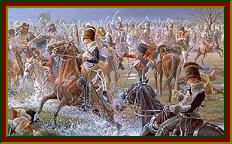
As Sir John Moore's men pulled away from Napoleon Bonaparte's fast-approaching army, the French sent 600 cavalry under General Charles Lefebvre-Desnouettes to disrupt the British retreat. At Benavente a small French cavalry force was ambushed and defeated by the British and German cavalry. French General Lefebvre-Desnouettes crossed the river and impetuously attacked the British and German cavalry. The enemy at first gave way. They caught the enemy rearguard at the River Coa. General Stewart soon brought in more cavalry. The French continued advancing, but the courage of a small group of British cavalry earned enough time for Henry Paget (Lord Uxbridge) to organise a defence. Paget, accompanied by a hussar regiment ambushed them and pursued the surprised and retreating enemy back across the Coa
The British suffered some dozen casualties and British-German cavalry captured 70-100 prisoners, including Lefebvre-Desnouettes. Despite the moral-boosting success in this small combat, Moore's retreat towards the sea continued. Soult, meanwhile, maintained the pressure on the fleeing British corps.
The straggler's battle at Betanzos of 10 January 1809 was an incident late in Sir John Moore's retreat to Corunna in the winter of 1808-1809. After a long retreat the British had made a stand at Lugo, but the pursuing French army under Marshal Soult had refused the strong British position, and at midnight on 8-9 January the British had slipped away, heading towards the coast at Betanzos. Discipline soon began to collapse, and large numbers of men fell behind the rearguard. On the morning of 10 January most of the army had reached Betanzos, while the rearguard under General Paget took up a position on some low hills just outside the town. From there they were able to observe the French cavalry under Franceschi as they began to round up large numbers of the stragglers. About 500 British soldiers were captured on 10 January, and a similar number had been lost on the previous day.
The losses were kept down by a spontaneous fight back on the part of some of the stragglers. As the French cavalry approached a large concentration of British troops in the villages at the foot of the hills, the more able bodied soldiers grabbed their muskets, and managed to hold off this first French charge with a rolling fire. At this point William Newman, a sergeant in the 43rd Regiment, took command of this impromptu force. He then divided into two companies, and conducted a skilful fighting retreat down the road into Betanzos, with the two companies covering each others retreats. Despite several French cavalry charges, the party of stragglers was able to reach the British lines in safety, while another 500 men are reported to have taken advantage of the distraction to escape from the French. Newman was rewarded for his achievement with an ensign's commission in the 1st West India Regiment.
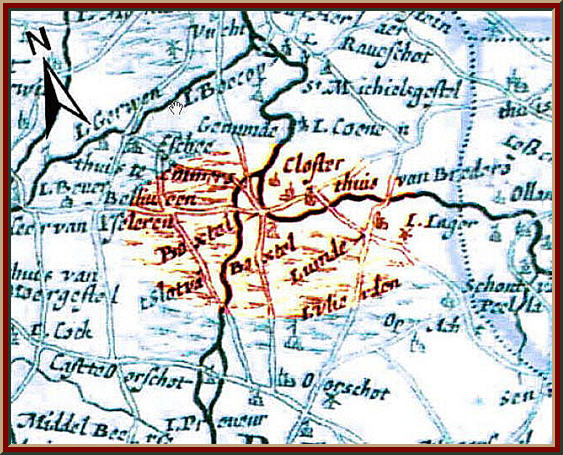
Part of the Flanders Campaign of 1793-94, the Battle of Boxtel was a minor incident during the Allied retreat from Belgium after the battle of Fleurus that is chiefly remembered for being the first time Arthur Wellesley, the future Duke of Wellington, came under fire in command of the British troops of the King's 33rd Foot. The allied expedition had planned to overthrow the French Revolutionaries by invading France from the north through Flanders in co-ordination with other similar attacks from different directions. These forces had initially been successful but had suffered a serious reverse outside Dunkirk and at Fleurus.
By 1794 the allies were retreating back northwards, pursued by an increasingly resurgent French army. In the aftermath of the Allied defeat at Fleurus the Austrians had begun to pull back east towards the line of the Rhine, abandoning any hope of recovering the Austrian Netherlands. This forced the British and Dutch to pull back towards the Netherlands, and by the end of August the Duke of York's British and German army was located between Hertogenbosch (Bois-le-Duc) and the Peel to the east (an area on the border of North Brabant and Limburg). The British line was protected by the River Aa, which runs south east from Hertogenbosch to the Peel, and the River Dommel, which runs south from 's Hertogenbosch to Boxtel and then turns south east to run alongside the Aa. In mid-September the French caught up with the Allied rearguard near the small town of Boxtel, on the Dommel river, and on the Kovering Moor, north of St. Oedenrode village, and south of Veghel.

General Pichegru, with the French Army of the North, had just advanced from Antwerp to Hoogstaeten, and had sent out a strong detachment to occupy Eindhoven. On 4 September Pichegru advanced north from Hoogstaeten as if he was about to threaten Breda, but on 10 September he turned east, and advanced towards the British outpost at Boxtel, which was defended by two battalions of Hessians. On 14 September the French captured Boxtel, defeating three German battalions from the Duke of York`s Allied army and taking the Hessians prisoner.
The next day, York sent a division commanded by Abercromby to recover the town. Abercromby was given ten infantry battalions and ten cavalry squadrons, with the infantry made up of the Guards Brigade and the 3rd Brigade. This second brigade contained four infantry battalions, amongst them Wellesley's 33rd Foot. As the senior colonel present, Wellesley commanded the brigade while John Sherbrooke, the second lieutenant colonel of the regiment, had command of the 33rd on the day.
As the British force advanced towards Boxtel, it became clear that they were in danger of running into Pichegru's main force and ran into an ambush. Abercromby decided to pull back to his starting point and was forced to retire in confusion, pursued by French cavalry. When two French infantry regiments turned to follow the British, the retreat threatened to turn into a rout, but the situation was saved by the 33rd Foot, who formed up into line and fired a series of disciplined volleys which drove off the French. The young Wellesley was not directly responsible for their good behaviour, but was given much of the credit. After this rearguard action the British returned to safety with the loss of only ninety men. The battle was a baptism of fire for Lieutenant Colonel Arthur Wellesley, future Duke of Wellington, who checked the French pursuit by close-range volley fire. The regiment lost 430 men dead, but only 6 of them killed by the French, the rest dying as a result of the weather and starvation).
In the aftermath of this failure the Duke of York realised that he could no longer hold his line of the Aa, and the British withdrew east to cross the Maas (Meuse) at Grave. They then took up a new position on the north bank of that river, with the Duke's headquarters at Wijceen. The French soon forced the British to give up this line as well, and at the start of October the Duke of York was forced to retreat across the Waal (a major branch of the Rhine). The British were able to continue their advance northwards and eventually reached the North Sea coast successfully, where they were withdrawn to Britain in 1795. The French pressed on to Amsterdam and overthrew the Dutch Republic and replaced it with a satellite state.
Burgos
19 September - 22 October, 1812, 10-12 June, 1813
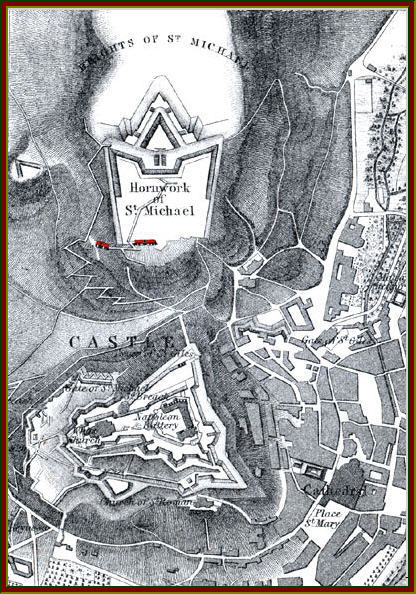
The Duke of Wellington laid siege to Burgos twice, the first being a costly failure, while the second a quick victory.
The first attempt against the 2000 Frenchmen garrisoning the fortress was hampered by huge amounts of rain and a lack of British siege artillery. Progress was woefully slow and despite gaining footholds in Burgos, the British were never able to seriously threaten its security. The gathering of two French forces to relieve the defenders sparked a British withdrawal. The month-long siege had cost Wellington more than 2000 men, while the French lost only some 600.
Ten months later, a second move on Burgos captured the city within two days.
 |
The action at the defile of Cacabellos, 3 January 1809, was a minor British victory during Sir John Moore's retreat to Corunna. It was fought between the British rearguard and the lead elements of Marshal Soult's pursuing army. The purpose of the British stand was to give Moore time to destroy the stores at his main supply depot at Villafranca, six miles to the west.
The British rearguard consisted of five battalions of the Reserve under the command of General Edward Paget, the 15th Hussars and a battery of horse-artillery. Most of this force was posted on the west bank of the river Cua, with one squadron of cavalry and half of the 95th Rifles on the east bank. The artillery, protected by the 28th, was placed on the slopes opposite the bridge over the river, with the remaining British troops hidden to either side.
The first French troops to reach the defile, at about one in the afternoon, were a cavalry brigade from Ney's corps (containing the 15th Chasseurs and the 3rd Hussars), under the command of General Colbert, and a division of dragoons under General Lahoussaye.
As the French approached, the 95th Rifles began to cross back over the bridge, while the squadron of British cavalry remained on the east bank to watch the French. Colbert observed this, and decided to attempt to force his way across the bridge with a cavalry charge. His first charge was a success - the British cavalry were forced to flee, reaching the bridge at the same time as the last of the rifles, causing chaos. The French took between 40 and 50 prisoners before the rest of the riflemen were able to escape.
Colbert was still on the east bank of the river, but from his position the only British troops in sight were the artillery and 28th. Accordingly he decided to try another cavalry charge. Forming his men into a column four wide, he led a charge across the bridge. Artillery fire destroyed the head of the column, but most of Colbert's cavalry made it across the bridge. Once there they came under a heavy cross fire from the 95th and 52nd regiments, posted north and south of the bridge. Colbert, and his aide-de-camp Latour-Maubourg were both killed, and after a few costly minutes the survivors retreated back across the bridge. Most of the 200 French casualties were suffered during this part of the battle.
Lahoussaye's dragoons then made a second attempt to force the British out of their position, wading across the river at a number of places, but the rocky terrain was ill-suited to cavalry, and they were forced to dismount and act as skirmishers, without success.
Finally, close to dusk, General Merle's infantry division arrived. After an hour of skirmishing, Merle formed a column and attempted to force his way across the bridge, but this left the French infantry dangerously exposed to the British artillery, and the attempt failed. As darkness fell the British rearguard was still in place, but that night they were withdrawn by Moore, and the retreat continued.
Both sides lost around 200 men in the fighting, which gave the British the time they needed to destroy their supply depot at Villafranca. The retreat to Corunna continued, and Moore's army came close to falling apart. In retrospect Moore has been criticised for the speed of the retreat, and his failure to take better advantage of strong defensive positions like the Cacabellos defile, although when he did offer battle at Lugo on 6-7 January, the French sensibly refused to take the bait.
Combat of Carpio
25 September 1811
The combat of Carpio of 25 September 1811 was a minor clash between Wellington's cavalry screen and part of a French army under Marmont that had just raised the blockade of Ciudad Rodrigo. Having raised the blockade, Marmont decided to carry out a strong cavalry reconnaissance to discover if Wellington was preparing for a siege. One of these columns, containing two cavalry brigades under the command of General Wathier, was sent west from Ciudad Rodrigo to investigate the line of the Azaba (or Azava) River. This brought them up against Wellington's left wing, where the 1st and 6th Divisions under General Graham were guarding the road to Almeida and the supply depot at Villa da Ponte, while Anson's brigade was providing a cavalry screen across the Carpio road (a village just to the east of the Azaba).
Wathier's advance forced Anson's men to abandon their picket line, and pull back behind the Azaba. Wathier then left six of his squadrons at Carpio, and crossed the river with the remaining eight. Graham responded by moving the light companies of Hulse's brigade to the edge of a line of trees just to the west of the river. Anson's cavalry - the 14th and 16th Light Dragoons) also drew back to the edge of the trees.
The woods made Wathier nervous and he decided to send four of his eight squadrons forward to investigate. When the first of these squadrons came close to the woods, it was charged by one squadron from the 14th Light Dragoons and forced back onto the other three. All four of the French squadrons then continued their advance. As they came close to the woods, the three British light companies opened fire, and before the French could recover the British cavalry charged again. This time the French cavalry turned and fled, and were chased back to the river. The French lost 11 dead and 37 captured during this skirmish, while the British only lost 11 wounded and one missing. Although only a minor clash, the combat of Carpio did confirm that the British had infantry west of Carpio, and helped to built up Marmont's picture of Wellington's rather scattered disposition.
Combat of Campo Mayor
25 March 1811
The combat of Campo Mayor of 25 March 1811 was the first Allied victory during Beresford's campaign in Estremadura in the spring of 1811. The town of Campo Mayor had only fallen to the French on 21 March, after an eight day siege, and a small detachment of French troops under General Latour-Maubourg had been left in the town to demolish the fortifications. In total Latour-Maubourg had 2,400 men - 900 cavalry from the 26th Dragoons and the 2nd and 10th Hussars, 1,200 infantry from the 100th Regiment of the Line, half a battery of horse artillery and a force of engineers whose job was to destroy the walls of Campo Mayor and those captured guns felt to be of no use.
The French were entirely unaware of the approach of Marshal Beresford's strong Anglo-Portuguese force, which on 24 March had reached Arronches. On that day the Portuguese cavalry had discovered Latour-Maubourg's outposts, three miles outside Campo Mayor. The French had been sighting forces of Portuguese cavalry on a regular basis since they reached the Badajoz area at the start of 1811, and so did not realize that these horsemen were the scouts of a major army.
On the morning of 25 March Beresford left Arronches, and advanced south east towards Campo Mayor. He split his force into three columns. In the centre, following the main road, was the 2nd Division, with the dragoons in front and Cole's 4th Division behind. Hamilton's Portuguese division with the 13th Light Dragoons and two squadrons of Portuguese cavalry were following a road a little further to the east, while Colborne's brigade and the rest of the Portuguese cavalry followed a ridge to the west.
Three prizes were available to the Allies. The most valuable was Latour-Maubourg's force, one quarter of the French army in Estremadura. Next was the siege train used to capture Campo Mayor and sixteen Portuguese heavy guns, all of which left the town early on the morning of 25 March, almost unguarded, on their way to Badajoz. Finally, if the Allies could capture Campo Mayor before the French could destroy the walls, then the town would be a useful base for further operations. In the end only the third of these prizes would be won.
At around 10.30am the Allied army came into sight from the French outposts. Latour-Maubourg happened to be visiting the outposts at the time, and so was amongst the first to realise that he was facing attack by 18,000 men. He returned to Campo Mayor at high speed, and ordered his force to abandon the town and their baggage, and prepare to retreat back to Badajoz as fast as possible. By the time the first British troops reached the ridges overlooking the town, the French were already on the move, with the dragoons in front, followed by one regiment of the hussars, then the infantry regiment in column of route (long and narrow), and the second hussar regiment to the rear.
If the Allies were to capture Latour-Maubourg's men, then their cavalry would have to hold up the French for long enough for the infantry to arrive on the scene. Wellington had developed a rather low opinion of the British cavalry. He was aware that few of his cavalry commanders had any experience of large scale engagements, and that a single disaster could destroy most of the British cavalry. Beresford had been warned not to risk his cavalry, and he passed that warning onto the General Long, the commander of his 1,500 cavalry. He was given orders to block the line of the French retreat, not to risk an attack against a superior force, but to strike a blow if he got the chance - somewhat contradictory orders that gave Long the leeway to do whatever he wanted.
The British and Portuguese cavalry finally came up on the French column three miles south east of Campo Mayor. The Allied force had split into two during the ride, with De Grey's dragoons to the west, close to the rear of the French column, and the 13th Light Dragoons and the Portuguese horse to the east, level with the French dragoons.
The two sides were very finely balanced. The Allies were outnumbered by the combined French force, but if they could drive off the French cavalry then the infantry would be vulnerable, especially with Allied infantry not far behind. Despite this, Latour-Maubourg decided to offer battle. He formed his infantry into battalion squares along the roads, with the hussars guarding the flanks and the dragoons draw back to the right ready to attack the Allied cavalry if they attacked the infantry.
Long decided to begin by driving off the French dragoons using the 13th Light Dragoons and the Portuguese cavalry. Latour-Maubourg responded by sending his 26th Dragoons to make a pre-emptive attack on the Allied light cavalry. The British 13th Light Dragoons had the best of the resulting melee, driving the French dragoons off the battlefield. Unfortunately for Long, the British cavalry then lived up to its poor reputation, and indulged in a seven mile pursuit of the broken French cavalry, which only ended when the French reached the safety of Badajoz. On their way they chanced across the French artillery convoy, but even that did not stop the headlong charge, and only a couple of the guns were captured.
This left Long with the Heavy Brigade and three squadrons from the 1st Portuguese cavalry to face 1,200 French infantry in squares supported by 500 hussars. His best chance of a decisive victory was gone, but he decided to attack anyway, in the belief that once the French cavalry was driven away, the infantry would surrender. This attack was never launched, for at this point Beresford reached the scene. He was informed that the 13th Light Dragoons were believed to have been lost, and will Wellington's warning not to destroy the cavalry in mind, cancelled the charge of the heavy brigade. Instead, he decided to wait for his nearest infantry column to arrive. Seeing that the British were no longer a direct threat, the French resumed their march towards Badajoz. Beresford trailed behind, waiting for Colborne's brigade to catch up, but by the time the British infantry were coming into range, so were 2,000 French reinforcements from Badajoz under Mortier. Beresford decided to abandon the chase.
The inconclusive results of the combat caused a great deal of controversy in the British army. Beresford and Wellington held that the charge of the 13th Light Dragoons had been wasteful, while Long argued that he had been within a few minutes of winning a conclusive victory when Beresford took command. At the time Beresford and Wellington had the best of the debate - Long was soon removed from command of the Allied cavalry, and Wellington issued a General Order reproving the cavalry for what he saw as a reckless charge. Since then the combat has been seen as a first sign of the indecision that would mark Beresford's time as an independent commander.
The combat of Casa de Salinas of 27 July 1809 was a preliminary action fought on the day before the main fighting at the battle of Talavera. On the morning of 27 July Sherbrooke's and Mackenzie's divisions of Wellesley's army had been posted on the east bank of the Alberche River, to guard the river crossings and make sure that the Spanish army of General Cuesta would be able to cross in safety. Having missed a chance to attack Marshal Victor's 1st Corps in isolation on 23 July, Cuesta had insisted on chasing the French east across the river, only to discover that Victor had been joined by General Sebastiani's 4th Corps and the Royal Reserve of King Joseph. Cuesta had been forced to retreat in some haste, reaching the Alberche on the evening of 26 July. He had then insisted on camping on the east bank of the river, and had only crossed to the west bank on the morning of 27 July. Once the Spanish were across the river, Wellesley withdrew his two divisions, and ordered them to move into their positions on the battlefield he had selected.
Mackenzie's division was ordered to act as a rearguard during this movement. It took up a position around a ruined house, the Casa de Salinas, about a mile west of the Alberche, in an area covered in olive groves. A line of pickets had been placed in front of the division, and Wellesley was using the house as a vantage point, in an attempt to monitor the French progress.
Mackenzie's division contained two brigades. Donkin's Brigade, to the left, contained two battalions of the line (2/87th and 1/88th) and half a battalion of the 5.60th Foot (the rifles). Mackenzie's own brigade, to the right, contained three battalions (2/24th, 2/31st and 1/45th).
Despite these efforts, Lapisse's division of Victor's 1st Corps had managed to cross the Alberche north of the British position without being observed. Having discovered Mackenzie's positions, Lapisse was able to launch a surprise attack on Donkin's Brigade and the left flank of Mackenzie's. The 87th, 88th and 31st Foot were all broken in the first attack, and for a moment the French had punched a hole in the British line.
Luckily for Wellesley, the 45th Foot on the right and the 60th on the left had held their ground, and Wellesley was able to rally the retreating regiments. The British infantry were then able to retreat under fire, until they reached open fields, where Anson's light cavalry were able to come to their aid. Although the French brought up some horse artillery, they were unable to further disrupt Mackenzie's movements, and his division soon took its place in the line.
The fighting around Casa de Salinas was surprisingly costly. The British lost 70 dead, 284 wounded and 93 missing in the skirmish, a total of 447 casualties. Donkin's brigade was hardest hit - it lost 289 of its 1,471 men in the clash, nearly 20% of its total strength. Both brigades would be involved in the fighting at Talavera on the following day, with Mackenzie's brigade suffering 632 casualties, second only to Langwerth's brigade. After two days of fighting, the brigade had suffered 785 casualties, losing one third of its strength.
Combat of Casal Novo
14 March 1811
The combat of Casal Novo of 14 March 1811 was a rearguard action during Masséna's retreat from Portugal that was notable for the reckless behaviour of General Erskine, the temporary commander of the British Light Division.
Having been forced out of his position at Condeixa on 13 March, Ney had taken up a new defensive position at Casal Novo. Marchand's division had a strong position on rising ground, protected by stone walls. When Erskine's men reached Casal Novo on the morning of 14 March the French position was hidden by fog. Erskine himself refused to believe the French were still in the village, and ordered three companies from the 52nd foot to clear away what he believed to be a thin line of French pickets. When the fog lifted it became clear that the five battalions of the Light Division were facing eleven French divisions, and a period of hard fighting followed, in which the British suffered 90 casualties.
The Light Division was saved by the arrival of the 3rd Division. When they began to move around the French left, Marchand pulled back towards Mermet's division, two miles to the east, and the two French divisions formed up on a new line.
This time the British carried out a more skilful outflanking manoeuvre, and the French were forced to retreat with little loss. The same happened again later in the day at Chão de Lamas. After being turned out of this position Ney retreated six miles to the Eça River and joined up with the rear of the 8th Corps. This ended the fighting for the day, although the same units would clash again on the following day at Foz do Arouce in the last significant clash between the French rearguard and the British vanguard of this stage of the campaign.
The British suffered 155 casualties, nearly two thirds of them in the first combat of the day. After this Erskine began to lose Wellington's confidence, completing that process at Sabugal on 3 April.
Combat of the Coa
24 July 1810
The Combat of the Coa of 24 July 1810 was a rare defeat for Craufurd's Light Division during Masséna's invasion of Portugal. Having successfully watched the French on the Portuguese frontier since the start of the year, the fall of Ciudad Rodrigo had forced Craufurd to retreat back to Almeida, with orders to pull back west across the Coa if the French approached in strength. Craufurd's position at Almeida was well suited to the sort of small scale action he had been fighting all year. His left flank was protected by the guns of the town, and his line of retreat back to the Coa offered a series of positions for rearguard actions, but it was also dangerously exposed if the French attacked in strength, for it was two miles from the river, and the final part of the journey was well out of range of the guns of Almeida. The river itself runs through a steep sided valley, while the road reaches the river to the left of the bridge and then runs along the river for a short distance.
On 21 July Marshal Masséna ordered Ney forward from Ciudad Rodrigo to found out if the British intended to defend Fort Concepcion, the Spanish fort opposite Almeida. Ney used Loison's division and Treillard's cavalry brigade to perform this task, and Craufurd promptly retreated from the Turones River to Almeida. Wellington had informed him that he did not want to fight east of the Coa, but had not actually ordered Craufurd to retreat west of that river. The British plan for defeating Masséna's invasion was to fall back before the French advance all the way to the Lines of Torres Vedras, and then to allow starvation to force the French to retreat, so there was little to be gained from fighting. Despite this, Craufurd decided to remain at Almeida for two days, in the expectation that the first French attack would not be in any great strength.
This rather underestimated Ney. Once he discovered that Craufurd was exposed outside Almeida with the river to his back, Ney decided to attack with his entire 24,000 strong corps. On the morning of 24 July the French advanced in four lines. Two cavalry brigades formed the first line, followed by a second line of thirteen infantry battalions, a third line of eleven battalions and a reserve of three regiments. When the French cavalry drove in the British pickets, Craufurd still had time to escape, but he did not realise how large the oncoming French column was, and held his ground for an hour while the French infantry advanced towards him.
Craufurd had five battalions in his line - the 43rd and 52nd Foot, the 95th Rifles and two battalions of Portuguese Caçadores. The first French attack was made by the thirteen battalions of the French second line. Despite their superior numbers, this attack was held off, but then the French 3rd Hussars managed to get between Craufurd's left and the walls of Almeida. They attacked one company of the Rifles from the flanks and almost wiped it out, causing twelve casualties and capturing 45 men out of an original force only 67 strong. The French cavalry was then held up by some stone walls, but it was clear that Craufurd's line was in danger, and he ordered a retreat.
The cavalry and the guns were sent off at the gallop, followed by the Portuguese, with the three British battalions forming a rearguard. At first all went well, but the kink in the road delayed the artillery, and the infantry arrived before the guns had crossed the river. Craufurd was forced to form up most of his British infantry on the east bank of the river to cover the retreat. At the same time the guns and the Caçadores were formed into a new line on the west bank, guarding the bridge.
Just as the main force of the infantry was about to cross the bridge, an isolated detachment of the 52nd came into sight, in imminent danger of being cut off. Only the quick thinking of Colonel Beckwith of the Rifles and Major McLeod of the 43rd saved them from being overwhelmed. Together they organised a counterattack, which forced the French back for long enough for the 52nd to reach safety.
Despite this close call, the Light Division had still suffered 300 unnecessary casualties. Ney had won an easy if limited victory, but he was not happy with this. Instead he decided to attempt to cross the narrow bridge over the Coa, in the face of almost the entire Light Division, which was now in place on the far bank. The first attempt, by the French 66th Line, got half way across before it was repulsed. Ney responded to this setback by sending his elite Chasseurs de la Siège to repeat the attempt. This battalion contained 300 of the best marksmen in the 6th Corps, and should not have been wasted in this way. In a ten minute long attempt to cross the bridge, this unit lost 90 dead and 147 wounded, leaving only 70 survivors.
Despite this disaster, Ney was still determined to force his way across the river, but a second attack by the 66th was beaten off easily. Ney finally gave up, and the two sides remaining in their position on the opposite sides of the river for the rest of the day.
Craufurd had been doubly lucky on 24 July. First he had escaped from a potentially devastating trap with the lose of only 318 men (36 dead, 189 wounded and 83 missing), when if the French had managed to block his route to the bridge he might have lost most of his division or have been forced to take refuge inside Almeida. Second, Ney's foolhardy attacks across the bridge had cost the French 527 casualties (117 dead and 410 wounded). What might have been seen as a costly and unnecessary defeat became a minor victory (although Wellington himself was not fooled)
The skirmish at Constantino of 5 January 1809 was a rear-guard action during Sir John Moore's retreat to Corunna in the winter of 1808-1809. It was fought to prevent the French from crossing over the bridge at Constantino after the British engineers were unable to blow up its central arch.
General Paget, commanding the British rearguard, placed his artillery in a position where they could command the passage of the bridge, with the 28th and 95th Regiments defending the near bank of the river.
The French vanguard was made up of General Lahoussaye's division of dragoons, and General Merle's division of infanty. Merle formed his infantry into a dense column, and attempted to force his way across the bridge, but this just exposed them to the British cannons and the attempt failed. Paget and the rearguard held out until dark, and then withdrew to Lugo, where they found the main army formed up ready to offer battle.
Battle of Copenhagen
2 April, 1801 (Sharpe's Prey)

Nelson’s plan was simple: his ships in line ahead would sail into the inner channel, Royal Passage, each anchoring in its appointed place and attacking its assigned Danish rival. Captain Riou was to lead a squadron of smaller ships and attack the Trekroner Citadel which was to be stormed by marines and soldiers at a suitable moment after it had been reduced by bombardment.
At 8am on 2nd April 1801 the assault began with His Majesty’s Ship Edgar leading the division from its anchorage and tacking from the Outer Deep into the Royal Passage. Immediately disaster struck Nelson’s division as Agamemnon, Nelson’s old ship, unable to weather the turn into the channel, ran aground on the shoal known as the Middle Ground. Polyphemus taking over Agamemnon’s lead role made the U turn into the Royal Passage and came under heavy fire from the Danish ship Provesteen.
The following ships, Isis, Glatton and Ardent, made the turn and anchoring engaged the Danish vessels they had been allocated. Attempting to pass these ships Bellona grounded on the Middle Ground shoal, as did the following Russell. Stuck fast these ships fired on the Danes as best they could, but several of the guns on Bellona burst killing their crews, due to the age or the miscasting of the barrels or overcharging in an effort to achieve greater range.
The grounding of Agamemnon, Bellona and Russell caused the Trekroner Citadel to be left unmarked, requiring Captain Riou to carry out the bombardment with his squadron of smaller vessels, the billowing smoke concealing his ships and protecting them initially from excessive damage. Nelson in Elephant took the anchorage allocated to Bellona, with Ganges and Monarch anchoring immediately in front of Elephant. With the line in place the battle fell to a slogging gunnery match between the British ships and the Danish ships and batteries, floating and land, which lasted some two hours.
To the North the commander in chief listened with increasing anxiety as the large ships of the line in his squadron beat slowly down the channel, the wind fair for Nelson but contrary for them. Seeing the intensity of the battle, Sir Hyde Parker concluded that he should take the opportunity to break off the action and hoisted the signal to disengage, giving the battle its most famed episode.
Nelson’s signal officer queried whether the signal should be repeated to the other ships, to which Nelson directed that only an acknowledgement was to be flown, while signal 16, the order for close action, be maintained. No ship in Nelson’s division acted on the signal except Captain Riou’s squadron, attacking the Trekroner Fortress. Riou, expecting that Nelson would call off the assault, turned his ship to begin the withdrawal. The Danes redoubled their fire causing significant damage and casualties on Riou’s ships, with one shot cutting down a party of marines and the next killing Riou himself.
Nelson turned to Colonel Stewart, commanding the contingent of soldiers carried in the fleet, and said “Do you know what’s shown on board of the commander in chief? Number 39, to leave off action! Leave off action! Now damn me if I do.” Turning next to his flag captain, Nelson said “You know, Foley, I have only one eye. I have a right to be blind sometimes.” Nelson then raised his telescope to his blind eye and said “I really do not see the signal.”
By 2pm much of the Danish line ceased firing, with ships adrift and on fire, several having surrendered, their captains on board Elephant. Captain Thesiger, a British officer with extensive experience of the Baltic after service in the Russian navy, went ashore with correspondence from Nelson to the Danish Crown Prince inviting an armistice. During the negotiations only the batteries on Amag Island, at the southern end of the Danish line, the Trekoner fortress and a few ships continued to fire.
A senior Danish officer, Adjutant General Lindholm, went on board Elephant to negotiate, directing the Trekroner to cease firing on his way. The British ships also ceased fire and the battle effectively ended. Defiance and Elephant went aground and the Danish Flagship, Dannebroge, grounded and blew up, with considerable casualties.
The next morning Nelson went aboard the Danish ship Syaelland, anchored under the guns of the Trekroner, and took the surrender of her captain Stein Bille, who refused to strike to any officer other than Nelson himself. British gunboats took the Danish vessel in tow to add to the clutch of Danish ships that had been taken in the battle. 19 Danish vessels were sunk, burnt or captured. Just before the battle, on 24th March 1801, the Tsar of Russia, Paul I, was murdered by members of the St Petersburg court and replaced by his anti-French son. The effect of the Battle of Copenhagen and the Tsar’s murder was to bring about the collapse of the Northern Confederation.
British casualties were 253 killed 688 wounded. No British ship was lost. The Danes lost 790 killed, 900 wounded and 2,000 made prisoner.
Cuidad Rodrigo
8 January, 1812 (Sharpe's Company)
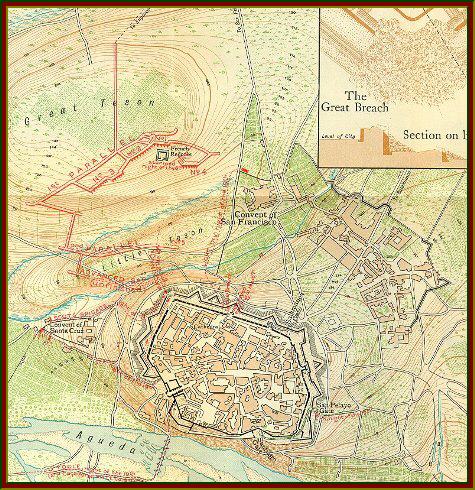
The start of one of the British army's most difficult clashes began at the border fortress of Ciudad Rodrigo on 8 January, 1812.
The bastion covered the northern gateway from Portugal to Spain and was crucial to both sides' plans for upcoming operations.
For the French it was to delay the Anglo-Portuguese, while for the Duke of Wellington it was necessary to remove it as a challenge to his supply lines.
After capturing a hill at the northern part of the town the British pounded away with cannon until two breaches had been created.
On the 19th, Wellington ordered an assault that eventually succeeded, albeit at great cost. Some 600 Allied troops died and Britain lost one of its best commanders in General Robert Craufurd.
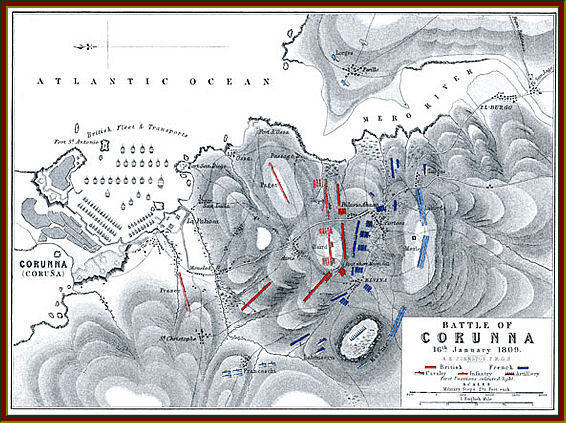
At the end of October 1808 the Emperor Napoleon, at the head of a large French army assembled in the northern Spanish city of Vitoria, prepared to place his brother Joseph on the throne of Spain by force. Several Spanish armies gathered to resist him and the British corps in Portugal was ordered to advance to Burgos and assist the Spanish. With the departure to England of Generals Burrard and Dalrymple and Sir Arthur Wellesley to face the enquiry into the Convention of Cintra which had enabled Junot and his army to escape from Portugal after the Battle of Vimeiro, command of the British army fell on Sir John Moore. Moore commanded 23,000 troops in Lisbon and expected 10,000 reinforcements to arrive at Corunna under Sir David Baird.
As Moore proudly declared, "No British general had commanded so many soldiers since the time of Marlborough". Moore sent his infantry by the northern route through Coimbra, Celerico and Badajoz to Salamanca in Spain. Late anxieties about the state of that road caused him to divert his artillery and cavalry by the southern Ciudad Rodrigo road.
Arriving at Salamanca, Moore learned that Napoleon had defeated the Spanish armies and was already in Burgos, Moore's intended destination. Soon afterwards the French entered Madrid. The British army, outnumbered by some two to one, was now heavily threatened. Nevertheless Moore felt reluctant to abandon the Spanish and advanced on Soult's corps in Valladolid.
But Moore had lingered within striking distance of the large French forces for too long. Napoleon was coming after him and it was imperative that the British army retreat with all speed to Corunna in the North West Galician corner of Spain for evacuation by the fleet. It was late in the year and the retreat was one of great hardship. From Astorgas, Napoleon left Marshal Soult to conduct the pursuit. The British rearguard comprising General Paget's reserve brigade, Colonel Craufurd's brigade and the Cavalry seized every opportunity to hold off the French. A skilful holding action was conducted by the cavalry at Benevente and by the whole army at Lugo.
Other than for the rearguard the discipline of many of the British regiments of foot disintegrated and the troops ravaged the countryside and villages through which they passed. A notorious incident took place at Bembibre where 200 British soldiers became so drunk in a cellar that they had to be left for the French.
The army marched into the port of Corunna on the night of 11th January 1809, many of the troops in a state of exhaustion. The French were some distance behind but the fleet was not in harbour. The transports did not reach Corunna from Vigo until 15th January 1809. Moore formed his army south of Corunna between the village of Elvina and the sea. Soult's corps carried out a frontal attack on the British line with the emphasis on the British right flank at Elvina. The French took Elvina but were driven out by the 42nd Highlanders and the 50th Foot. They counter-attacked and recaptured the village. Short of ammunition, the two regiments returned to the assault led by Moore and the French were driven out again at the point of the bayonet. At the moment of victory Sir John Moore was struck by a round shot and fatally injured. Lying stricken, Sir John enquired as to the state of the battle and was reassured that the French had been beaten back. The French attack along the British line faded away, Paget's reserve division driving back a late incursion around the open right flank. The next day the army was embarked on the transports. One of the last duties of the 9th Foot was to bury Sir John Moore on the city ramparts.
 |
 |
Combat of El Bodon
25 September 1811
The combat of El Bodon of 25 September 1811 was a lucky escape for the British and Portuguese army on the Spanish border in the autumn of 1811. Wellington had been blockading Ciudad Rodrigo since August, but he was not strong enough to risk besieging the place, in the knowledge that if pushed the French could raise a much larger army to raise the siege. Even the blockade would eventually provoke a French response, and so Wellington picked out a strong position to fight a defensive position, at Fuento Guinaldo, fourteen miles to the south west of Ciudad Rodrigo.
The French response came at the end of September. Marshal Marmont, command of the Army of Portugal, and General Dorsenne, commander of the Army of the North, combined their forces to produce a field army around 58,000 strong (with 52,000 infantry and 4,500 cavalry). On 22 September Marmont appeared at Tamames, twenty miles to the east of Ciudad Rodrigo, while Dorsenne was a few miles further north at San Muñoz.
At this point Wellington had 46,000 men (including 41,000 infantry and 3,100 cavalry) facing Ciudad Rodrigo. His army was spread out in an arc to the west and south of Ciudad Rodrigo. At the left of the line were the 1st and 6th Divisions, under the command of General Graham, west of the town, on the River Azava (or Azaba). Wellington and the 4th Division were at Fuento Guinaldo, ten miles to the south, at the south western tip of the line. Next in line was the 3rd Division, at El Bodon, six miles north of Wellington, and almost half way to Ciudad. Finally the Light Division was posted at Martiago, another three miles to the east and almost due south of the town.
This deployment exposed each fragment of Wellington's army to the risk of a crushing defeat before reinforcements could reach them. It also made it almost impossible for Wellington to concentrate his army at Fuente Guinaldo without interference, for the French could easily thrust into the gap between the widely separated left and right wings. Wellington left his troops in this dangerous position because he did not believe that the French intended to advance beyond Ciudad Rodrigo.
The French cavalry established contact with the blockaded town on 23 September, and on the next day half of the French infantry appeared on the plains outside the town. On 25 September Marmont decided to try and discover if Wellington was preparing for a regular siege. He sent out two large cavalry forces to investigate the areas west and south of the town. Both ran into Wellington's men. The western thrust was repulsed at Carpio, without serious fighting, but the southern thrust came close to causing a major disaster.
The force sent south consisted of two brigades of dragoons and two brigades of light horse, under the command of General Montbrun. The only infantry involved was Thiébault's division, which was moved onto the southern bank of the Agueda, into a position close to the town, where it could support the cavalry if needed.
Montbrun's cavalry easily broke through Wellington's cavalry screen (here made up of Alton's brigade), and then found itself in the middle of Picton's 3rd Division. Picton had not had time to concentrate his divison, and so his infantry was stretched out along a six mile front, in four separate clusters, each two or three battalions strong. The nearest support was the 4th Division, a further six miles to the south west.
Marmont had no way to know how vulnerable the 3rd Division was at this point, and assumed that Wellington would have reserves close by. He ordered Montbrun to pick one of the isolated parts of the 3rd Division and force his way past it in an attempt to discover the main force he believed must be close by.
Montbrun decided to attack along the road from Ciudad Rodrigo to Fuente Guinaldo (this road does not appear on modern maps, which show a road that runs from Ciudad to El Boden, and then on to Fuento Guinaldo, presumably to avoid the high ground involved in this fight). This road was defended by part of Colville's brigade - the 1/5th and 77th Foot and the 21st Portuguese, posted on a plateau at the top of a steep slope. If the French cavalry could push its way past this force quickly, then the eastern half of the 3rd Division (the 1/45th and 1/88th at El Boden and the 74th and three companies of the 5/60th at Pastores, on the Agueda) would have been trapped.
Montbrun had 2,500 cavalry to attack a British force of 1,000 infantry, 500 cavalry and two batteries of field artillery, although the British did have the advantage of defending the high ground. Montbrun decided to attack in three columns. His left and centre columns attacked the 500 men of Alten's cavalry, while the right column attacked the Portuguese artillery and the 1/5th foot.
Both of these attacks failed. Despite being outnumbered by around two-to-one, Alten's cavalry were able to use the slope to their advantage to prevent the French from reaching the plateau, launched a series of charges against the most advanced French troops, forcing them to retreat, before themselves withdrawing back up the slope. The colonel of the Hussars of the King's German Legion involved in this fight reported that the French made forty separate attacks, while each of the British and German regiments involved made eight or nine charges.
The column attacking the guns met with more initial success. Despite coming under heavy fire from the Portuguese guns, the dragoons managed to reach their position, capturing four guns. While the French cavalry was still disordered amongst the guns, Major Ridge of the 1/5th ordered his men to advance in line. The dragoons faced three volleys of musketry before fleeing back down the hill.
After the repulse of this frontal assault, Montbrun decided to send one his brigades around the right of the allied position, into the gap between the road and El Boden. This move forced the British to retreat, but it came too late, for the troops at El Boden and Pastores had already escaped.
Montbrun continued to attack the small British force throughout the retreat. They were retreating with the artillery at the head of their column, followed by the 21st Portuguese, marching a square, then the 5th and 77th Foot in a single square, and with the remaining cavalry in the rear.
The French cavalry soon drove off the cavalry rearguard, leaving the square of the 5th and 77th vulnerable to attack. Montbrun's men attacked it from three sides at once, but without success. The British cavalry then charged the disordered French horse, and forced them to retreat, winning half-an-hour of peace for the retreating infantry.
By now the troops retreating from the fight on the hill had caught up with Picton and the troops from El Bodon and the three battalions from the west. For the rest of the march the 21st Portuguese and 5th and 77th formed a rearguard, still marching in their two squares, while the rest of Picton's men remained in their columns. The French harassed the retreating columns, but Montbrun was no longer willing to risk further cavalry charges. Instead he attempted to bring his horse artillery into use, and on several occasions managed to fire on the British column.
The French were eventually forced to retire when the 3rd Division came close to the fortified camp at Fuente Guinaldo and Wellington sent out more cavalry to support the retreating column.
The combat of El Boden cost the British and Portuguese 149 casualties, 68 of them in the cavalry (13 dead, 50 wounded and 5 missing). The total French losses were not reported, but 13 officers were killed or wounded, suggesting a total lose of around 200 men.
The danger was not yet over. By the end of the day Marmont had 20,000 men over the Aqueda, with the rest of his army close behind. Wellington only had the 3rd and 4th Divisions, Pack's Portuguese brigade and part of his cavalry at Fuente Guinaldo, a total of around 15,000 men. It would take most of the next day for the Light Division to arrive, while the 13,000 men from the British left never reached the camp, but despite this Marmont refused to attack. It would appear that the French defeats at Bussaco and Fuentes de Oñoro had made Marmont unwilling to attack Wellington in a prepared position.
On the night of 26 September Wellington evacuated Fuente Guinaldo, well aware that his position was not as strong as the French believed, and made for his second defensive position, inside Portugal. By the end of 27 September Wellington's army was concentrated around Alfayates, although only after having fought a rear-guard action at Aldea de Ponte.
 |
Combat of Foz de Arouce
15 March 1811
The combat of Foz de Arouce of 15 March 1811 was the least successful of Marshal Ney's rearguard actions during Masséna's retreat from Portugal in the spring of 1811. After a night march on 14-15 March most of the French army had crossed the Ceira River at Foz de Arouce, and had camped on the heights above the village.
Ney had been ordered to bring all of his troops across the river, and destroy the bridge behind him, but Ney disobeyed this order, and kept three brigades on the southern side of the river (All of Marchand's division and one brigade from Mermet's, containing the 25th Léger and the 27th Ligne). This deployment risked disaster, for the Ceira was in flood and the only possible escape route for Ney's men was across the damaged bridge of Foz de Arouce.
Wellington's pursuit on 15 March was delayed by a combination of a heavy fog and fires that the French had set in the town of Miranda de Corvo. The 3rd and Light Divisions did not reach the French positions on the Ceira until four in the afternoon, and seeing the French arrayed in some strength decided to camp and wait for the rest of army to catch up with them on the next day.
Wellington himself arrived just before dusk, and decided to attempt to surprise
the French. Ney's men were clearly not expecting an attack that late in the
day, and were caught by surprise. The Light Division attacked the French right
and the 3rd Division their left. The greatest success was achieved by some companies
from the 95th Rifles, who managed to reach the centre of Foz de Arouce, and
threatened to capture the bridge.
Hearing gunfire in their rear, the French 39th Ligne broke, and attempted to cross the bridge. Their route was blocked by some French cavalry, attempting to re-cross the river to take part in the fight, and the infantry were forced to try and use a ford. The river was too high for this, and a significant number of the French were swept away and drowned. Perhaps even worse for their morale, the regiment's eagle was lost, swept away by the waters (it was later recovered by the allies and sent to London).
Ney managed to retrieve the situation, charging the 95th Rifles with the third battalion of the 69th Ligne, and forcing them to retreat. With the passage of the bridge secured, the French were able to retreat to the north bank of the river, although they came under artillery fire from both sides as they crossed the bridge!
The British suffered 71 casualties during the fighting at Foz de Arouce. French
losses were much heavier, somewhere between 250 and 400. Only the lateness of
the day and the fading light prevented the British from inflicting much heavier
casualties on the retreating French.
The combat at Foz de Arouce effectively ended the close pursuit of the French. Wellington let his men rest on the following day, partly to allow a supply convoy to arrive and partly because he was satisfied that Masséna had no choice but to retreat all the way to Spain, for between Foz de Arouce and the border there were no areas where the French army could hope to find enough supplies to remain for any length of time. The French would briefly attempt to hold a position on the Alva River, but without success.
Fuentes d'Onoro
3 and 5 May, 1811 (Sharpe's Battle)
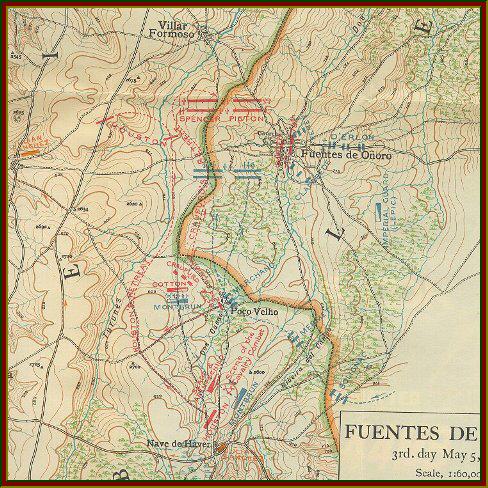
Desperate to relieve the besieged fortress of Almeida, Marshal Massena moved with almost 50,000 men towards his target, but found himself up against some 36,000 troops under the Duke of Wellington.
The first clash came on the 3rd, when five French battalions were sent against just over 2000 British light infantrymen. After heavy fighting the defenders were ejected from the village, but a counterattack by three regiments retook it. The British suffered 259 casualties to more than 650 by the French.
Skirmishing on the 4th was replaced by a serious attempt by Massena to gain the village. An early assault by infantry and cavalry routed Spanish cavalry units and the British horsemen, under General Sir Stapleton Cotton. The push against the right was only just held off by Wellington's men, but they managed to conduct a textbook withdrawal in the face of the enemy. Halting at prepared defensive lines, the British kept the attackers at bay on the right while the village of Fuentes was bitterly defended. A steady stream of reinforcements allowed Wellington to hold the position against up to 28 enemy battalions thrown at it. Massena withdrew leaving 2192 men behind as opposed to Wellington's 1500.
 |
Garcia Hernandez
23 July, 1812 (Sharpe's Sword)
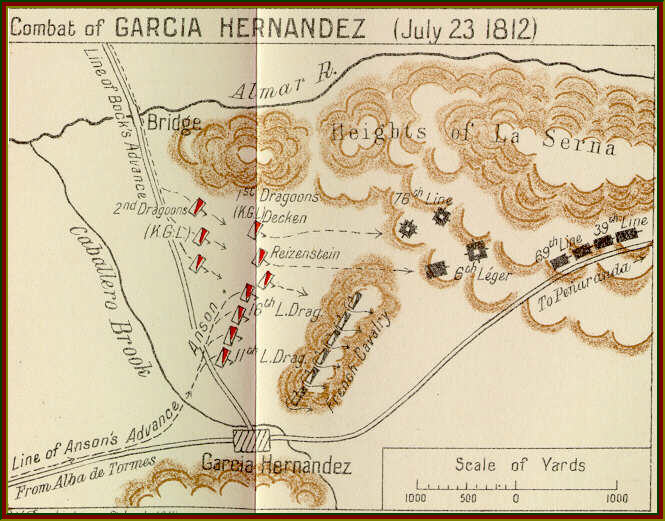
This action is known for being one of the few times that cavalry has managed to break a formed infantry square. The honour goes to the King's German Legion's General Bock, who set his 450 men on to three battalions of French infantry retreating after the battle of Salamanca. The four KGL squadrons charged uphill, broke the square and then proceeded to rout a column. Bock's men suffered 150 casualties while General Foy's shocked defenders lost 1400 men.
Gawilghur was the well-fortified mountain stronghold of the Maratha Empire north of the Deccan Plateau, in Maharashtra. It was popularly considered impregnable, but was successfully assaulted by an Anglo-Indian force commanded by Arthur Wellesley on the 15 December, 1803 during the Second Anglo-Maratha War.
Scindia's forces had retreated to the mountain stronghold after their stunning defeat at Assaye. A practiacable breach was made on the outer walls but the inner fort was unscathed. After many casualties and two failed attempts at the main gate from British and Sepoy companies, Captain Campbell led the 94th Scottish Brigade (light company) on a daring assault, up the ravine dividing the inner and outer forts and into the inner fort by escalade, the Scots then forced the northern gatehouse and opened the many gates allowing the remaining British force entry. The British suffered few casualties in the final assault (~150), but in the subsequent uncontrolled sack it is estimated that almost half of the seven thousand Indians within the fort were killed.
The fortress was returned to the Marathas' after making peace with the British but they abandoned it, leaving unrepaired breaches made by British guns, which remain to this day.
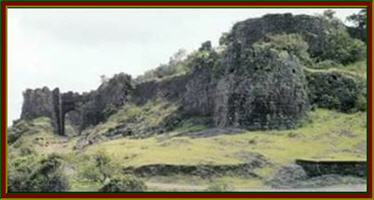
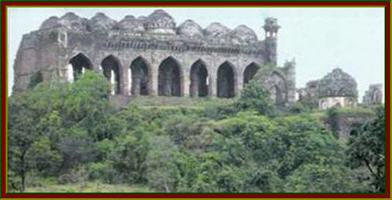
Grijon
11 May 1809 (Sharpe's Havoc)
The combat of Grijon of 11 May 1809 was the second action during Sir Arthur Wellesley's campaign in northern Portugal of 1809. The target of the campaign was Marshal Soult's army at Oporto, which had fallen to the French on 29 March. After failing to capture Soult's advance guard at Albergaria Nova on 10 May, Wellesley now faced the first serious test of his army. The French had 4,200 infantry and 1,200 cavalry, under Generals Mermot and Franceschi in a strong position on a ridge
Wellesley had Edward Paget's division (the brigades of Murray and Richard Stewart), Hill's brigade and Cotton's cavalry, a total of 7,000 infantry and 1,500 cavalry, with Hill's men some way to the west of the battlefield.
Wellesley's first move was designed to find out if the French intended to stand and fight. The light companies from Stewart's brigade were sent to attack the French skirmishers in the woods in front of the French position, and were soon repulsed.
Wellesley then decided to launch three outflanking manoeuvres. Two miles to the west, Hill was sent along the coastal road from Ovar to Oporto, a move that threatened the entire French position. At Grijon itself a battalion from the 16th Portuguese Regiment attacked around the French right, and two battalions of the King's German Legion attacked on the left. This was the first time Wellesley had seen the Portuguese troops in combat, and he was reassured by what he saw, for the 16th was one of the best of the new units, and it made good progress against the French right.
When they saw that their flanks were threatened, Mermot and Franceschi ordered a retreat across the farmland between Girjon and Oporto. This was a area of small fields divided up by stone walls, which made it unsuited to a cavalry pursuit, although the 20th Light Dragoons did catch part of the 31st Léger, capturing 100 prisoners and inflicting nearly as many casualties. After spending most of the day moving north, the French reached the southern suburb of Oporto on the evening of 11 May, and that night crossed into Oporto, destroying the bridge behind them. Soult now believed he was secure in the city, for he believed that he had removed all the boats from the southern banks, and began to prepare for a leisurely retreat. Much to his surprise, on 12 May Wellesley crossed the river above Oporto, and forced the French to evacuate the city.
Combat of Guarda
29 March 1811
The combat of Guarda of 29 March 1811 was a bloodless British victory in the last stages of Masséna's retreat from Portugal. Having reached relative safety at Celorico, Masséna decided on a dramatic change of direction. Instead of continuing on the road to Ciudad Rodrigo, he decided to turn south, and attempt to reach the Tagus valley. This route took him across two mountain ranges, and even if successful would have seen the French army isolated in a desolate part of the country. Marshal Ney disagreed so strongly with this plan that he officially refused to obey it, and was replaced as the command of 6th Corps by General Loison.
After a few days in the mountain it became clear that Masséna's plan was completely unrealistic, and on 29 March abandoned his plan. The army was now to move towards Sabugal, in the Coa valley, from where it could reach safety in Spain. Loison's 6th Corps formed the French rearguard, and on 29 March was camped in a strong position around the high mountain town of Guarda.
At this point Wellington had no idea of the crisis in the French camp, or of Masséna's two changes of plan. When the French left the obvious route to Ciudad Rodrigo, Wellington assumed that they were heading for Sabugal and Spain. Only when the French seemed to have stopped at Guarda did Wellington decide that he needed to move them on, and it then took some days for the army to come together.
On 29 March Wellington was finally ready to move. Three divisions were sent to push the French out of Guarda. The Light Division was to attack from the north, Alexander Campbell's 6th Division from the north west and Picton's division from the west. Their advance was protected by a cavalry screen.
Ney had carried out a series of skilful rearguard actions during the retreat from Lisbon, but Loison would prove to be much less capable. The British advance caught him entirely by surprise. One of his divisions had already moved off the hill at Guarda, and the Light Division appeared to threaten his line of retreat. Seeing this, Loison ordered his corps to abandon their positions, and to retreat south east to the Coa. The French retreat was carried out at such high speed that the British infantry were unable to catch up with them, while the cavalry were able to capture no more than 300 prisoners.
 |
 |
 |
 |
 |
The fighting at Lugo on 7 January 1809 was the closest that the British and
French came to fighting a full scale battle during Sir John Moore's retreat
to Corunna over the winter of 1808-1809.
By 6 January Moore's army was concentrated around Lugo, fifty miles inland from Corunna. During the retreat the army had become very scattered and discipline had begun to break down, and so Moore had decided to rest for a few days. His main aim was to bring his army back together, and give it time to rest, but it is also possible that he had decided make a stand. A final factor in the decision to rest at Lugo was that Moore had only recently decided which port he was heading for. The alternatives were Vigo, on the west coast, or Corunna and Ferrol to the north west. He had decided in favour of Corunna at Herrerias (near to Villafranca). This meant that the advance guard heading for Vigo needed to change direction, and make for Lugo, but Moore's orders did not reach them promptly, and one division spent most of 5 January marching and countermarching through the mountains before finally reaching Lugo.
The British had a strong position at Lugo. Their flanks were protected by the river Minho to the right and by inaccessible hills to the left, while their front line was protected by a line of low stone walls. Moore's army also turned out to be rather larger than he had believed - partly because 1,800 fresh troops were waiting at Lugo, and partly because a large number of stragglers rejoined their units when they learnt that a battle was likely. In all the British had around 19,000 men at Lugo.
Marshal Soult reached Lugo on 6 January, but his army had also been stretched out during the long march through the mountains, so only half of it was with him on that day. Even after the other half arrived on 7 January, the French were probably outnumbered by the British. At full strength Soult's army would have contained 20,000 infantry and 6,000 cavalry, but by the time it reached Lugo he is reported to have had 13,000 infantry and 4,000 cavalry, a total of 17,000 men.
At first Soult did not know whether he was facing Moore's entire army, or just Paget's rearguard. On 7 January he made a series of probing attacks, starting with an artillery bombardment of the British centre. This was soon silenced by fire from fifteen British guns, several times more than Paget had deployed in the rearguard actions at Cacabellos and Constantino. He then launched a feint against the British right, which was seen off by the Brigade of Guards.
The most serious fighting came on the left, where the 2nd Léger and 36th Line regiments of Merle's division launched an attack which was beaten back by Leith's brigade.
This ended the fighting at Lugo. On 8 January Soult decided to wait for reinforcements to arrive. On the British side Moore had prepared his men for a battle, but as the day wore on it became increasingly clear that the French were not going to attack. Moore dismissed any suggestion that he should launch an attack. He had every reason to believe that Soult's army was at least as large as his, and the French were in just as strong a defensive position as the British. A costly victory would have been as disastrous as a defeat, for there was a second French army under Marshal Ney close behind.
Accordingly, at midnight on 8-9 January the British slipped out of their lines, and resumed the retreat to Corunna. Moore had hoped that the rest at Lugo was restore the discipline of his men, but he was sadly mistaken, and the army once again began to dissolve into a disorganized mob, that would only come back together as an army at Corunna. Fortunately for Moore, this did not apply to Paget's rearguard, which retained its discipline all the way to the coast. The battle that so many of Moore's men wanted finally came at Corunna, on 16 January 1809.
 |

As the British siege of St. Sebastian got underway on July 14, 1813, the French army, now reconstituted, reorganized and under the supreme command of Marshal Soult, prepared to execute a large counter-attack with the objectives of relieving the blockade of Pamplona, dealing a blow to Wellington's army and regaining the initiative in the war. One of the two main avenues chosen to reach Pamplona through the Pyrenees was the Col (or Pass) of Maya. The task of assaulting and carrying this pass was given to Lt. Gen. D'Erlon, who commanded three divisions of infantry led by General's Abbe, Maransin and Darmagnac: a total force of roughly 21,000 bayonets. To oppose him, Wellington had put Lt. Gen. Rowland Hill in command of the Baztan, a high mountain valley with entries and exits in many directions, not least Pamplona and Maya. At the Col de Maya exit, Hill placed the 2nd Division (less a brigade) under Lt. Gen. William Stewart. Of the three brigades of the division assigned to Maya, Cameron's was positioned in the pass itself while Pringle's was placed further down into the valley about the town of Maya proper. Ashworth's Portuguese Brigade was seven miles to the south east guarding the Ispegui Pass.
At 10:30 am on July 25, the French attack on the pass began. Gen. D'Erlon sent Darmagnac's Division, 7,000 strong, up a track from the town of Espelette and overwhelmed a 400 man outpost on the Gorospil peak on the east side of the Col, in a short time making casualties or prisoners of every one of this large piquet. Against this French lodgment, the British counter-attacked desperately, but in a piecemeal fashion, and all or part of every one of Stewart's and Pringles battalions: the 50th, 92nd, 71st, 28th, 24th and 39th were bloodily repulsed after gallant assaults against a well-situated and superior force.
The British recoiled west along the crest of the pass and took up a second position, across the Chemin Anglais (or English Road) where it intersects the main track over the pass coming up from the French town of Urdax. Up this muddy conveyance came another French Division: the 6,000 bayonets of Gen. Maransin, which went into the attack on this second position and drove back the British again, over-running the camps of the 71st and 92nd in the process. It was at this time, about 4:30pm, when the 82nd Regiment arrived. It had heard the sounds of battle in the morning and had formed up, receiving orders from Stewart to advance well after the battle had began. Following the Chemin Anglais from its camp, the regiment skirted the north side of the Alcorrunz Peak just in time to see the French over-running the British encampments at the summit of the pass.
The regiment immediately joined the reserve line as the British retired in echelon. As the British retreated, it took the front position and, being relatively fresh, delivered several shattering volleys, three cheers and a bayonet charge into the advancing French, driving the lead battalions in on their supports. Within a few desperate minutes, 650 men drove back 6,000. Also at this time, a company of the 82nd was sent to the crest of a steep knoll on the left of the line, where they joined a company of the 92nd already in place, forming a strong position and holding it against repeated French attacks. As the impetus of the 82nd's counter-attack faltered, the weight of French numbers soon began to push the British back again, down onto the south side of the pass. The companies of the 82nd and 92nd on the knoll were cut off by this advance, but continued to hold out. There the company of 82nd men, upon running out of cartridges for their Brown Besses, resorted to the novel expedient of throwing stones at their adversaries clambering up the slope: a display of stubbornness mentioned in dispatches after the battle. Down at the main line, Gen. Stewart, wounded in the leg and observing the direness of the situation, prepared to order a retreat farther down the valley.
At this point, about 6pm, the British again received much needed reinforcements from the 7th Division. Two battalions: the 6th Foot and the Brunswick-Oels of Barne's Brigade, had been marching hard all day from Echelar and poured out suddenly from a side-road a little south of the Alcorrunz peak, crashing into the advancing French right flank like a thunderbolt. In the French battalion that took the brunt of their charge, fifteen officers fell within a minute. Their fiery onset rallied the 82nd and the other regiments already engaged and accompanied by the deadly accuracy of the Brunswick rifles, within a short time, the French masses were bundled back up to the crest of the pass, but no further.
In desperation, D'Erlon posted a fresh brigade from Abbe's Division across the height and from this strong position the French held their ground. By 8pm the battle was over. The French had been contained in the pass by the hard fighting of the 2nd Division and the timely reinforcements of the 7th, including the initial support by the 82nd Regiment. Eight brave soldiers from the 82nd were slain in the pass that day, while 4 officers and 67 men were wounded: a total of 79 casualties. Wellington later described the counter-attack of the 82nd as "the admiration of all who witnessed it"
Passage of the Misarella
17 May 1809 (Sharpe's Havoc)
The passage of the Misarella River of 17 May 1809 saw Marshal Soult's army get past the last major barrier between them and relative safety during their retreat from Oporto in May 1809. On the night of 15/16 May, the French had forced their way across the Ponte Nova, on the main road across the mountains from Braga to Chaves, and by the end of 16 May had reached Ruivaens. There Soult had to make a choice of route - he could continue along the main road the Chaves, and hope that General Beresford's Portuguese army had not yet reached the town, or he could turn north and take the road across the mountains to the border town of Montalegre. He chose the second option (correctly, for just after Soult reached Ruivaens, Beresford reached Chaves).
The only really dangerous obstacle on the road to Montalegre was the bridge across the Misarella River. This bridge was known as the Saltador, normally translated as the "leaper", although the "bouncer" seems to be more accurate. This bridge carried the road across a single arch over the Misarella, and was the only possible route for Soult's army. If the bridge had been destroyed, or was defended by regular troops, then the French would have been in serious trouble.
Luckily for Soult, the bridge was only defended by a few hundred poorly armed local levies, who had been gathered together by Major Warre, a staff officer in Beresford's army. They had refused to destroy the bridge, for it was also their only means of communication across the valley, but they had removed the balustrades, and built an abattis across the far end of the bridge.
The passage of the Ponte Nova had been led by Major Dulong, reputed to be the bravest officer in Soult's army. He was now called on again to lead an assault across a narrow bridge. This time the bridge itself was in better shape (the Ponte Nova had been reduced to two four foot wide beams), but there was more determined opposition on the far bank, and the French did not have time to wait for darkness, for the British were approaching the French rearguard at Salamonde.
Dulong was given one company of voltigeurs to make the assault and two battalions of infantry to follow them over if. He formed his company into a long column only four men wide (the most the bridge would allow), and led them in a charge across the bridge.
The attack was an immediate success. On their first rush the French reached the far bank, broke down the abattis and scattered the Portuguese levies. The rest of Soult's army crossed behind them, and that evening reached Montalegre. Wellesley halted his pursuit at the Saltador, although he did sent a Portuguese force towards Montalegre on 18 May, but by then Soult's men were well on their way to Orense, back in Spain, where they were able to rest and regroup. Although Soult had rescued most of his men, he had been forced to abandon all of his artillery, his heavy baggage, most of the plunder taken at Oporto, and $50,000 of gold coins. It would be months before Soult's corps could play an active part in the war.
 |
Navas de Membrillo
29 December 1811
The combat of Navas de Membrillo of 29 December 1811 was a minor clash between a British and Portuguese expedition under General Hill and part of the French garrison of Estremadura. Hill had spent two inactive months on the Portuguese border, before receiving orders to conduct a raid towards Merida, where part of Dombrouski's 5th French Division was relatively isolated. Wellington hoped that this expedition would distract Soult from his pursuit of the small Spanish army of General Ballesteros and from the siege of Tarifa.
Hill crossed into Spain on 27 December with 12,000 men, and advanced along the north bank of the Guadiana River. On 29 December, with his column close to Merida, Hill was unlucky enough to run into a small French detachment which had been sent out to find supplies. This force was made up of three companies from the 88th Regiment supported by a troop of hussars. Hill ordered two squadrons from the 13th Light Dragoons and two from the 2nd Hussars of the King's German Legion to attack this force, but Captain Neveux, commanding the infantry, formed his men into squares and ordered them to retreat towards a nearby forest of cork trees.
Hill's cavalry made five attempts to charge the French squares, each without success. After the fifth charge the French reached the safety of the trees, and were able to escape to Merida, after losing two dead and nine wounded. The British cavalry lost 3 dead and 36 wounded in their attempts to break into the French squares. Forewarned of Hill's approach, Dombrouski evacuated Merida and began to retreat back toward Soult's army in Andalusia. Hill occupied Merida, taking 160,000lb of wheat. He then pressed the French as they continued their retreat, fighting a second action at Los Santos on 3 January. Once it became clear that the French had been forced to abandon the siege of Tarifa, Hill pulled back into Portugal.
 |
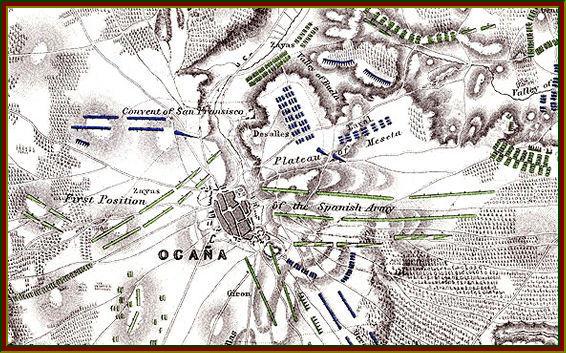
Following Talavera and the British withdrawal to Portugal, Spain's General Juan Carlos Areizaga concentrated an army of some 50,000 men to defend southern Spain. Despite his sizeable force, Areizaga made the mistake of staying too long in one place and allowed France's Marshal Soult to concentrate his available forces - some 29,000 men - and make an attempt to bring the Spaniards to battle.
Realising his enemy's intentions, Areizaga quickly retreated but was caught at Ocana.
Soult's cavalry decided the battle and the centre of the Spanish army and Marshal Soult crushed a major Spanish force almost twice the size of his own. Areizaga lost 4000 casualties and a further 15,000 men captured, while Soult's army suffered some 2000 killed and wounded.
Oporto
12 May, 1809 (Sharpe's Havoc)
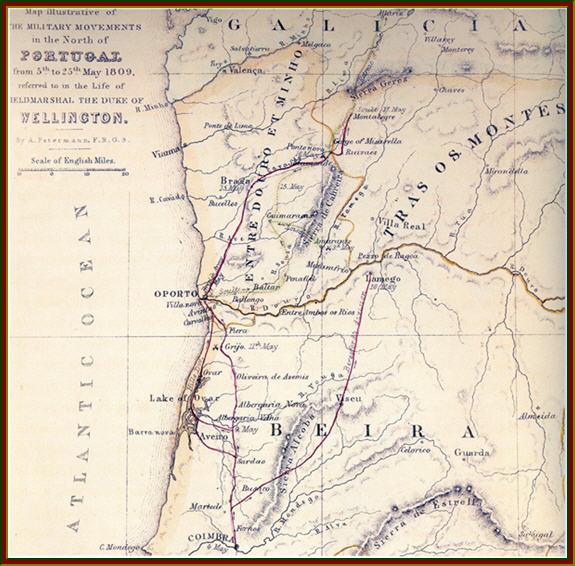
With the inquiry into the distasteful Convention of Cintra behind him, Sir Arthur Wellesley returned to the Peninsula and again took up command of British forces there.
The French still threatened that country through armies under Marshal Soult and Marshal Victor and so Wellesley decided to go on the offensive and remove the danger. He decided to attack Oporto, situated on the far side of the deep River Douro, despite the presence of Soult's troops in the city and the fact that the only bridge had been destroyed by French engineers. To add to his difficulties, Soult had removed all of the city's barges to the northern - French - bank.
In the early hours of the morning of the 12th, local Portuguese assisted British troops in recovering four wine barges from the north bank and, upon their return to the British side, they were loaded with the redcoat advance party. The target for the 120 or so men was the strongly built seminary to the east of the town. It was a perfect position for defending a bridgehead.
Despite crossing the river in daylight, the British were not initially spotted by French sentries - who later mistook them for Swiss troops - and within half an hour had several hundred men preparing defences in the seminary.
Protected by artillery batteries from a convent on the southern bank, the seminary would be a tough nut for the French to crack, as the local commander General Maximilien Foy discovered when he moved to throw the British out.
Launching an initial assault with three battalions at about 10.30am, Foy's men came under ferocious fire from cannons firing shrapnel. Several assaults were beaten back and by midday more reinforcements had arrived for the British under the command of General Sir Rowland Hill.
In addition to the crossing by the seminary, Wellesley had sent a large force six kilometres to the east to flank the French forces and it began its deployment via ferry. With an ever-increasing supply of boats being taken to the British by the local inhabitants, Soult decided his outnumbered force would not be able to hold off greater numbers of enemy troops and so he ordered a hasty withdrawal.
Hill's troops now went on to the offensive and pursued the French, who would have been trapped had it not been for slow work by the force sent to control the flank.
Oporto was a brilliant tactical effort from Wellesley, whose force succeeded in the highly daring venture with the loss of just over 120 men. Soult's force suffered up to 600 men killed and a further 1500 were captured in the town's hospital. That night Wellesley and his staff sat down at the former French headquarters and enjoyed a meal prepared for Soult and his officers.
 |
Combat of Pombal
11 March 1811
The combat of Pombal of 11 March 1811 was a skilful rearguard action fought by Marshal Ney during the retreat from the Lines of Torres Vedras. Marshal Messéna had originally intended to retreat north to take up new positions in the Mondego valley, with the intention of remaining in Portugal until reinforcements reached him. For this plan to succeed, his rearguard needed to delay Wellington for long enough for the vanguard to force their way across the river and capture Coimbra.
The French rearguard was commanded by Marshal Ney, and contained the divisions of Marchand and Mermet. For the first few days of the retreat the only Allied troops close to the French were the Light Division, under the temporary command of Sir William Erskine, and Pack's Portuguese Brigade. Wellington had ordered all but 3,000 of his 46,000 men to concentrate against the main French line of retreat, but it took several days for the scattered Allied forces to come together.
On 10 March Ney was based at the town of Pombal, with Junot's corps five miles further north, with the British vanguard close by. On the next morning Picton's 3rd Division joined the vanguard. When Ney realised that stronger forces had come up, he sent one of his divisions back towards Junot, leaving Mermet in position on the hills above Pombal, with one battalion defending the castle in Pombal.
Wellington saw this isolated battalion, and decided to attempt to cut it off. Elder's battalion of Caçadores (Portuguese light infantry) and two companies from the 95th rifles were ordered to attack across the bridge at Pombal, with the Light Division in support, while Picton was sent off to the left to outflank the French position.
Elder's small force managed to fight its way across the bridge, and up to the castle. When Ney realised that the battalion in the castle was in danger of being cut off, he led four battalions from the 6th Léger and the 69th Ligne down from the heights, sweeping Edler's men back out of the town. He then blockaded the main street and set fire to a number of houses, before retiring back up the hill with his entire force. The Light Division became entangled in the town, while the 3rd Division did not arrive until late in the day, and over cover of darkness the French fell back to Redinha, fighting a second rearguard action there on the following day
Passage of the Ponte Nova
15/16 May 1809 (Sharpe's Havoc)
The passage of the Ponte Nova of 15/16 May 1809 was one of the most daring exploits during Marshal Soult's retreat from Oporto of May 1809. In the aftermath of Sir Arthur Wellesley's victory at Oporto on 12 May, Soult had been forced to retreat across the mountains towards safety in Galicia. By 15 May he had reached the road between Braga and Chaves, and was heading east hoping to escape into Spain via Chaves, or if that route was blocked then by the side road to Montalegre.
To reach either of those places, Soult's army had to cross the Ponte Nova (New Bridge) just to the east of Salamonde. This took the road across the deep ravine of the Cavado River, and was the only possible route through the mountains. Soult knew that he did not have any time to spare, for the British had reached Braga on the morning of 15 May, and their cavalry was pressing his rearguard. If he could not cross the Ponte Nova on 16 May, then his entire army would be forced to surrender.
When Soult's advance guard reached the Ponte Nova they made an alarming discovery. The bridge was made up of two beams that crossed the ravine, each three or four feet wide, which supported a wooden roadway and the balustrades. The local Ordenanza (the Portuguese levy) had removed that roadway and the balustrades, leaving only the two long narrow beams. They had then blockaded the far end of the bridge.
Soult decided to send a forlorn hope across the beams. He sent for Major Dulong of the 31st Léger, the officer reputed to be the bravest man in the army, and ordered him to lead that attack. He was to find 100 volunteers, and at midnight on the night of 15/16 May lead them across the narrow beams. The weather was appalling - it had been raining for days, so the beams were wet and slippery, and there was a fierce north wind blowing. If the far end of the bridge had been guarded by regular troops, then this would have been a suicide mission.
At midnight Dulong led his forlorn hope across the beams, in two single files. The dreaded fire from the far bank never came, for the poor weather had driven the Ordenanza back into their huts, and no guards had been left at the bridge. Dulong's men attacked the sleeping Ordenanza in their huts, and forced them to flee. The only French casualty came when one of the volunteers slipped and fell off the beam.
With the bridge in their hands, the French quickly build a new roadway between the beams, using any materials that came to hand. After six hours a rough bridge was in place, although without balustrades, and the army began to make its way across the new Ponte Nova.
This would take all day. Soult decided to post a rearguard in the narrow section of the valley at Salamonde, leaving behind one brigade from Merle's division and two regiments of Franceschi's cavalry. The first British troops, light dragoons, found the French rearguard at 1.30 pm, but did not have the strength to attack them. That attack would not be made until the following day (Combat of Salamonde), and would end with the French rearguard fleeing across their impromptu bridge, while on the same day Dulong would be forced to repeat his daring exploits at the Misarella.
 |
 |
Combat of Redinha
12 March 1811
The combat of Redinha of 12 March 1811 was the second rearguard action fought during Masséna's retreat from the Lines of Torres Vedras in the spring of 1811. Having held off the British at Pombal on 11 March, Marshal Ney and the French rearguard had retreated to Redinha. Here he took up an apparently vulnerable position, with Mermet's division on a plateau south of the village, and Marchand's division north of the village on the far side of the Ancos River, linked by a narrow bridge, but Wellington was aware that he was close to much larger French formations, and proceeded very carefully.
Only at two in the afternoon, when the Light Division, Pack's Portuguese Division and Picton's 3rd Division had been joined by the 4th Division, with the 1st and 6th Divisions close behind, did Wellington begin his attack. The 3rd Division attacked around the French left and the Light Division around their right. After twenty minutes Ney's flanks were both threatened and he ordered Mermet to retreat back across the river. This order was given just in time, for the French suffered heavy casualties while crossing the bridge, but managed to escape in good order.
While the British were slowly crossing the stream, the two French divisions were able form up in a new line two miles beyond the village. Once again Wellington attempted to turn both flanks, and once again Ney retreated once his flanks were in real danger, this time pulling back to the village of Condeixa.
Ney has been praised for his handling of the rearguard. For the lose of 229 men he had held Wellington up for an entire day, giving Masséne the time he needed to force his way across the Mondego River. Unfortunately for the French Masséne failed to take advantage of that chance. At the end of 12 March the French were still to the south of the river, and in danger of being trapped by Wellington. The only alternative route open to Masséne was to retreat east towards the Spanish border, and the only road available led east from Condeixa. With the British close to that village, on the morning of 13 March Masséna began the long costly retreat back into Spain which marked the complete failure of his great invasion of Portugal.
Skirmish of Rio Mayor
19 January 1811 (Sharpe's Escape)
The skirmish of Rio Mayor of 19 January 1811 was one of the very few significant clashes to take place while Marshal Masséna's army was camped at Santarem, after his retreat from the front of the lines of Torres Vedras. One of Masséna's biggest problems during his time at Santarem was that he had to spread his three army corps out help them forage for supplies. Junot was on the upper Rio Mayor, with Ney some distance to the east, around Thomar and Golegão. It was perfectly possible that Wellington could launch a surprise attack on Junot's corps and inflict a heavy defeat on him before reinforcements could arrive.
Wellington did have troops close to Junot's position. The village of Rio Mayor was held by two companies of Portuguese infantry, with Pack's Portuguese brigade just to the south, and a small cavalry screen formed by one squadron from the 1st Hussars of the King's German Legion. In mid January rumours reached Masséna that an English infantry division had joined Pack, and so he ordered Junot to carry out a reconnaissance along the road that led south from his position, through Rio Mayor and on to Alcoentre.
On 19 January Junot took a force of 3,000 infantry and 500 cavalry to carry out this reconnaissance. The cavalry screen and the troops in Rio Mayor were quickly pushed aside. Pack formed his brigade up on some hills behind Rio Mayor. It was clear that there was no British infantry division present, and so Junot ordered his men back into their camps. During this brief fight Junot was hit by a musket ball which broke his nose before lodging in his cheek. This was a painful but not dangerous wound, and after a few days Junot was able to return to duty.
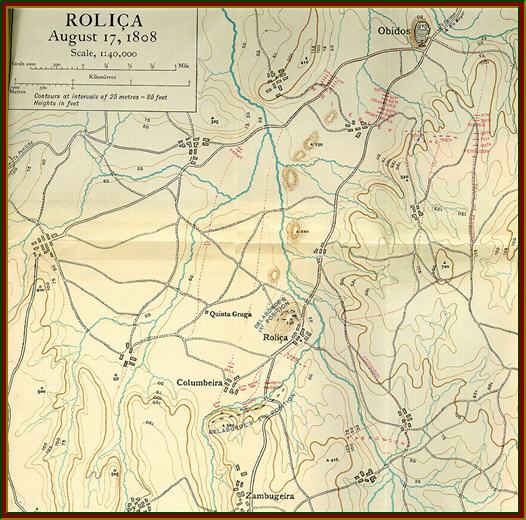
The battle of Rolica, 17 August 1808, was the first battle of the British involvement in the Peninsular War, and the first victory for Sir Arthur Wellesley. The Spanish uprising against Napoleon finally gave the British a theatre where their command of the sea would give the British army a chance to get involved in the war in a useful way. Portugal was seen as the ideal first step - the country was a long standing ally and it was believed that General Junot, commanding the French troops in the country, only had 5000 men. It was decided to send 10,000 men from Ireland under the command of Wellesley to Portugal. It would soon become apparent that Junot had many more men than had been believed, and the expedition was doubled in size. Wellesley was superseded by General Sir Hew Dalrymple, and ended up only fourth in command of the new force. He was, however, the man on the ground. Dalrymple and his second in command would not arrive until 21 August, by which time Wellesley had already won the campaign.
The British landed at Mondego Bay, some way to the north of Lisbon. Wellesley had command of his original 10,000 men, a force 5,000 strong brought up from Gibraltar and 1,500-2,000 Portuguese troops under Colonel Trant. On 10 August Wellington left Mondego Bay at the head of 13,000 British and perhaps 2,000 Portuguese troops, heading south along the coastal road towards Lisbon.
Junot sent General Delaborde and 6,000 men north to slow the British advance to give him time to concentrate his forces around Lisbon. By the time of the battle at Rolica, Delaborde's force had probably been reduced to around 4,000 men, some having been withdrawn by Junot to form a Grenadier reserve and others having been left behind as garrisons. After a preliminary skirmish at Obidos, Delaborde took up his main position at Rolica.
The French position at Rolica was a strong one. The British had to advance along a valley, flanked by hills and with a line of hills at the far end. Delaborde took up a first position on the hill of Rolica, some way in front of the ridge at the end of the valley, but with the intention of retreating to this second line as soon as the British threatened the first position. That second position, on the ridge at the end of the valley, was protected by ravines on both flanks, and by a steep hillside, itself cut up by gullies.
On the morning of 17 August, Wellington decided to launch a pincer attack on the first French position. He would attack up the centre with most of his infantry. Major General Ferguson would attack to the left and Colonel Trant with his Portuguese troops to the right. At the moment this pincer movement began to threaten the French position, Delaborde ordered his men back to the second position.
Wellesley intended to launch another pincer attack on this new position, but before the flank attacks could get into place part of his central front became engaged in the fighting and had to be reinforced. Two hours of gallant but bloody British attacks followed, each being repulsed, before finally the British were able to gain a lodgement at the top of the ridge.
At this point Delaborde ordered a retreat, which was carried out with some skill and the bulk of his army was able to escape. Although the British had been attacking a strong position, the French suffered higher casualties - 600 men killed, wounded or taken prisoner, while the British lost 474 men in the attack.
Although the fight at Rolica was a relatively minor affair, it provided a great morale boost to the British as the first victory over the French on European soil for some years. It also introduced the French to the deadly accuracy of the Baker rifle and the tactics of the 95th Rifles. The British were not able to follow up their victory with a determined pursuit. On 17 August British reinforcements had arrived off the Portuguese coast, and Wellesley moved his army to Vimiero, close to the mouth of the Madeira River to rendezvous with these new elements.
 |
The combat of Sabugal of 3 April 1811 was the last serious fighting during Masséna's retreat from Portugal in 1811, and was a missed chance for a major Allied victory over an isolated portion of Masséna's army.
Having reached relative safety at Celorico, Masséna had decided to abandon his retreat back to Ciudad Rodrigo, and instead attempt to cross the mountains of central Portugal to reach the Tagus River, from where he hoped to threaten Lisbon once again. This was an utterly impractical idea, and on 29 March, after several days of hard marching in the mountains Masséna was forced to abandon this plan. Instead he ordered his scattered corps to come back together around Sabugal, at the southern end of the Coa Valley. From there they would be able to march north, down the valley towards Almeida, or east towards the Spanish border.
Wellington had observed the move into the mountains, but had assumed that Sabugal was its original target. He had only decided to move when the French seemed to have decided to stop in the mountain town of Guarda. On 29 March three of Wellington's divisions forced Loison's 6th Corps out of their position at Guarda without a fight. By 31 March all of Masséna's corps had reached the Coa valley, and were in a position to reach safety without any further interference.
Masséna's final destination was the Spanish border around Ciudad Rodrigo, at the edge of the plains of Leon, where his army could finally find supplies. However, rather than continue his march into Spain, having reached the Coa, Masséna decided to let his men rest for a few days.
The three French corps on the Coa were stretched rather thinly along the river. Reynier's 2nd Corps was at the south of the line at Sabugal. The nearest units of the 6th Corps were seven miles further north, starting at Bismula. Finally, the 8th Corps was ten miles to the east, at Alfayates.
Wellington decided to gather his entire field army together, and to attempt to inflict a crushing defeat on Reynier's 2nd Corps. He now had 38,000 men in his six divisions (1st, 3rd, 5th, 6th, 7th and Light). Masséna's total force on the Coa was slightly larger, with 39,905 men, but Wellington hoped to defeat Reynier before Junot or Loison could come to his assistance.
Wellington's plan used all six of his divisions. The 6th Division was sent north to keep Loison pinned in place. The Light Division, under the temporary command of General Erskine, supported by two cavalry brigades, was to move around the French left flank. His role was to get behind Reynier and prevent him from retreating eastwards. Once Erskine was under way, the 5th Division was to attack at Sabugal, and the 3rd Division a little further south, with the 1st and 7th Divisions following behind.
Wellington's plan was derailed by a combination of fog and General Erskine. The morning of 3 April was foggy. Unable to see their objectives, Picton and Dunlop, the commanders of the 3rd and 5th Divisions, halted, and asked Wellington for new orders. Unfortunately Erskine was less careful, and blundered onwards in the mist, with Beckwith's brigade in the lead (the 1/43rd of the Line, four companies of the 1/95th Rifles and the Portuguese 3rd Caçadores). In the fog Beckwith's men crossed the Coa nearly a mile north of their intended crossing point. They then advanced through the mist, pushing back a line of French pickets.
What Beckwith's men did not yet know was that they were heading straight for Merles's division, at the southern tip of the French line. Merle had been alerted to the British attack by the sound of musket fire in the mist, and had just managed to form the 4th Léger into a new line facing south when Beckwith emerged out of the mist. Although the French had four battalions in their new line, they were actually outnumbered by Beckwith's two and half battalions. Despite this Merle attempted to attack the British and Portuguese line in four columns, and was predictably repulsed.
Beckwith chased the retreating French until he came up against the next two French regiments, the 36th of the Line and the 2nd Léger. This time it was Beckwith who at first was forced to retreat, but his men then found shelter behind some stone walls, and fought off the two French regiments. Beckwith then advanced for a third time, driving off Merle's divisional artillery. This third advance ended when the 4th Léger rallied and attacked Beckwith's left, while two squadrons of French cavalry attacked his right. Once again Beckwith was forced to retreat back to the stone walls.
At this point Beckwith's 1,500 men were being attacked by 3,500, and were in real danger, but fortunately for them at this point 2,000 men of Drummond's brigade arrived on the scene. Even so, when the mist finally lifted the isolated Light Division was still in danger.
When the mist lifted, both commanders could finally see what was happening. Picton's 3rd Division was able to advance up the hill to attack the right flank of the French forces facing the Light Division, and Reynier was forced to order a retreat. At first Picton conducted a pursuit, but then it began to rain torrentially, blocking all visibility, and rather than run the risk of having Picton's men blunder into strong French reinforcements, Wellington called off the chase.
Although the mist had prevented Wellington from winning a major victory at Sabugal, the Light Division had achieved a notable minor success. Reynier had suffered at least 760 casualties (72 dead, 502 wounded and 186 wounded), while Wellington had lost 162 men (17 dead, 129 wounded and 6 missing). Of the British casualties, 80 were in the 1/43rd Foot, who had fought off three separate French attacks.
In the aftermath of the battle, Masséna was forced to abandon his remaining positions on the Coa, and retreat rapidly to the east. Over the next few days the French finally reached relative safety in Spain. Even then the fighting was not over. When Wellington began a blockade of Almeida, Masséna attempted to break the siege, but was defeated for a final time at Fuentes de Onoro, 3-5 May 1811. Soon after that he was officially replaced in command of the Army of Portugal, ending his military career.
Salamanca
22 July, 1812 (Sharpe's Sword)
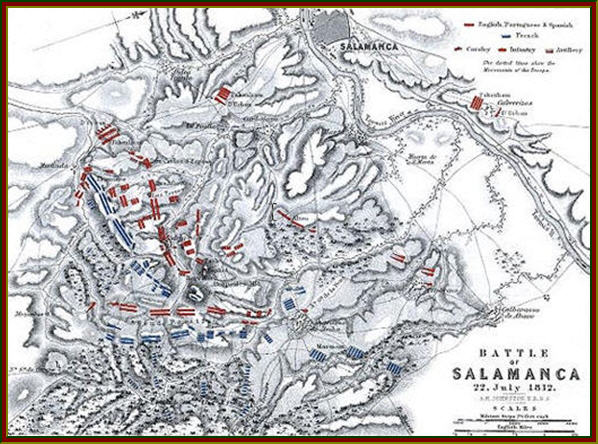
Armor and more French troops were siphoned from Spain to prepare for the advance on Russia, the British position in the Peninsula became stronger. The Duke of Wellington was determined to maintain the pressure on his immediate counterpart, Marshal Marmont, and a dance of manouevre began as each side strove to get the upper hand.
Wellington gained the advantage by capturing a series of forts at Salamanca, but word of fast-approaching additional French troops reached him. The British then set about preparing for another retreat to Portugal, with wagon convoys ordered to move the sick and injured, as well as baggage and unrequired stores, towards Ciudad Rodrigo. News of Wellington's imminent evacuation reached Marmont and he moved his army of 50,000 men, bolstered by almost 80 cannons, to try to catch the British on the march. He arrived at Salamanca on 21 July, but the only fighting was an initial series of fierce light-infantry skirmishes. The next morning, Marmont planned his battle and made two major mistakes.
The terrain around Salamanca was filled with dead ground that hid many areas from view and he thought the left wing of Wellington's army was only a small rearguard force. The dusty clouds he could see in the distance added to his perception that the British were pulling out and so he decided to swing most of his army around the delaying force and cut Wellington off from Portugal. When the British commander saw Marmont marching his army across the front of his own drawn-up, but hidden force of some 48,000 men, he let out a whoop of delight. He knew that by doing so, Marmont had potentially led his men into serious trouble. The French position was not helped by the fact that the leading troops were outpacing the rest of the army, which was slowly being split into several bodies of men.
Wellington acted quickly and sent his brother-in-law, Sir Edward Pakenham, and his 3rd Division to stop the advance of the French troops. The assault caught the French unawares and scattered a full division almost instantly. Then, Wellington ordered a combined infantry and cavalry attack upon the second block of two French divisions which, also caught by surprise, were smashed and routed. During the fighting, one of Britain's best cavalry commanders - General John Le Marchant - was killed, and Marmont left the field, wounded by an exploding shell.
The battle had only been going for some 40 minutes and it was effectively already won by the British. However, the new French commander General Bertrand Clausel quickly stabilised the situation, fending off two British attacks and then going on to the offensive himself. In a superb combined infantry and cavalry attack he inflicted serious losses on the British 4th Division and, as he advanced into the centre of Wellington's men, looked as if he could be on the verge of a seemingly improbable victory.
Quickly repositioning his men, Wellington caught Clausel's attack in a vicious crossfire that firstly halted them, then broke them. It was a costly success, with heavy casualties on both sides. With the French now on the verge of defeat Wellington released a counterattack that broke their cohesion and scattered them. Clausel's entire army could have been trapped had it not been for the failure of a Spanish force to block an escape route at the bridge at Alba de Tormes.
More than 7000 French troops were killed or wounded, a further 7000 captured, while the British and their Portuguese allies suffered just under 5000 casualties. Salamanca was the decisive battle Wellington had needed to prise open France's grip on the Peninsula.
Salamonde
17 May 1809 (Sharpe's Havoc)
The combat of Salamonde of 17 May 1809 was the only serious fighting during Marshal Soult's retreat after his defeat at Oporto on 12 May. On the night of 15/16 May the French had managed to force a passage across the Ponte Nova, just east of Salamonde, but it soon became clear on the morning of 16 May that it would take most of the day for the army to cross the newly repaired bridge. Accordingly, Marshal Soult detached one infantry brigade from Merle's division and two of Franceschi's cavalry regiments to defend the line of a ravine that cut across the road close to Salamonde.
Sir Arthur Wellesley's army was close behind, but not close enough to risk attacking the French rearguard on 16 May. At 1.30pm some light dragoons reached the French position, but realised that they were not strong enough to risk an attack, and so settled down to wait for reinforcements.
At 5pm on 17 May the Guard's brigade reached Salamonde. Wellesley decided to risk an attack on the French position with the forces already at his disposal. These included three companies of light infantry and two three-pounder cannons. Wellesley began by using those two cannons to bombard the French centre. At the same time the light infantry were sent to attack the French left flank in the cliffs south of the road.
Once the light infantry were engaged with the French left, Wellesley ended his two-cannon bombardment, and attacked with the Guards battalions. The French line broke and fled, with the British in close pursuit. The rout turned into a disaster at the Nova Ponte. The rebuilt bridge lacked balustrades, and as the French attempted to cross it, in the dark and in disorder, the British brought up their two cannons and began to bombard the rear of the French force. The effects of their bombardment were hidden in the dark, but the next morning the British realised that hundreds of French soldiers had plunged to their deaths in the gorge below the bridge.
Despite their easy victory over the French rearguard, the British were unable to catch Soult's main force. On the same day as the combat at Salamonde, Soult's men had forced their way across the Misarella River, and at the end of the day they reached the border town of Montalegre. Wellesley would halt his pursuit at the Misarella, and prepare to move back to central Portugal.
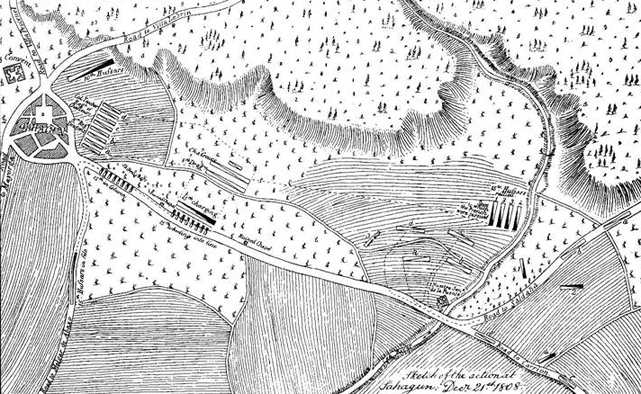
Leading Sir John Moore's cavalry vanguard towards Burgos, Henry Paget (Lord Uxbridge) decided to deal with a French cavalry force based at Sahagun. Setting off with the 15th and 10th Hussars, Paget arrived near the town and split his force to catch the French as they withdrew. He sent General Slade with the 10th to attack Sahagun, which sheltered some 600 dragoons, but the general moved too slowly and when the French discovered the attack column they moved to retreat.
As they left Sahagun the French noticed Paget's 15th, but mistook them for Spanish horsemen and moved on to the attack. Instead of unsteady Spanish troopers opposing them, General Debelle's cavalry found themselves facing a charge by some 400 British hussars.
Within seconds the French front rank had caved in and the rear one was scattered, turning a formed battle into a bitter duel-like struggle between individual horsemen. Debelle and half his men escaped, but left behind at least 120 men killed and more than 160 captured. Paget lost two dead and a score injured.
San Sebastian
7 July - 8 September, 1813

The port and fortress of San Sebastian was a French strongpoint on the northern coast of Spain that threatened the supply lines of any army moving into France. To prepare for the invasion of France, the Duke of Wellington had to clear the potential menace posed by General Louis Rey and his garrison of 3000 men.
The siege began on 7 July and an impatient Wellington ordered a storming on the 25th. The British attack was repulsed with heavy losses and the reports of a French counterattack through the Pyrenees forced the commander to weaken his besieging force and move to stop Marshal Soult's offensive.
When the danger had been ended at the battle of Sorauren, Wellington moved back to San Sebastian and brought his full force against the defenders. On 31 August he sent in a second attack and despite heavy losses - more than 2000 men - the British captured the town, although the French still held the important castle.
With the failure of a final relief attempt in early September, Rey had little choice but to negotiate a surrender. He and his men were allowed to march out with full honours of war, having defied Wellington's army for more than two months. Rey's men had suffered more than 2000 casualities, while the British lost almost twice as many
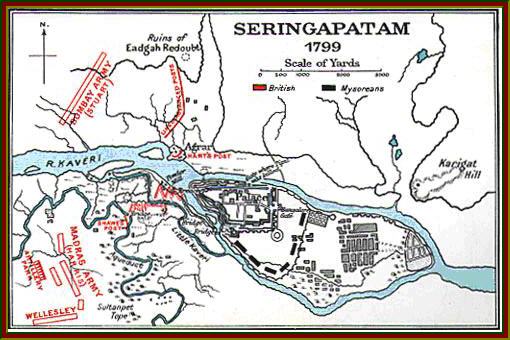 Seringapatam was besieged by the British forces on April 5, 1799. The Kaveri River (River Cauvery), which flowed around the city of Seringapatam, was at its lowest level of the year and could be forded by infantry-if an assault was commenced before the monsoon. When letters were exchanged with Tipoo it seemed that the Sultan was playing for time. He requested two persons to be sent to him for discussions and also stated that he was preoccupied with hunting expeditions.
Seringapatam was besieged by the British forces on April 5, 1799. The Kaveri River (River Cauvery), which flowed around the city of Seringapatam, was at its lowest level of the year and could be forded by infantry-if an assault was commenced before the monsoon. When letters were exchanged with Tipoo it seemed that the Sultan was playing for time. He requested two persons to be sent to him for discussions and also stated that he was preoccupied with hunting expeditions.
Tipoo Sultan's prime minister Mir Saadiq was a traitor bought by the British. He pulled out the Maysurian army for paying wages in the midst of the battle, thus allowing British forces to storm the boundary wall with little defence. Another key treachery to help the British was the spilling of water in the basements where the Sultan's army stored its gunpowder, which rendered the gunpowder useless.
The leader of the British troops was Major General David Baird, an implacable enemy of the Sultan: twenty years earlier, he had been held captive by the Sultan for 44 months. The storming troops, including men of the 73rd and 74th regiments, clambered up the breach and fought their way along the ramparts. After the Company troops had taken the city, the Sultan's body was found among the dead, shot in the head and stripped of his jewels.
The assault was to begin at 1:00 p.m. to coincide with the hottest part of the day when the defenders would be taking refreshment. Led by two forlorn-hopes, two columns would advance upon the defences around the breach, then wheel right and left to take over the fortifications. A third reserve column, commanded by Arthur Wellesley would deploy as required to provide support where needed.
At 11:00 a.m., on May 4, the British troops were briefed and whisky and a biscuit issued to the European soldiers, before the signal to attack was given. The forlorn-hopes numbering seventy-six men led the charge. The columns quickly formed, were ordered to fix bayonets, and began to move forward. The storming troops, including men of the 73rd and 74th regiments, dashed across the Kaveri River in water four feet deep, with covering fire from British batteries and within 16 minutes had clambered up the breach and fought their way along the ramparts and swept aside the defenders. The column that rounded the North-West corner of the outer wall was immediately involved in a serious fight with a group of Mysorean warriors under a short fat officer, that defended every traverse. The officer was observed to be discharging at the British loaded hunting weapons that were passed to him by servants at his service.
The leader of the British troops was Major General David Baird, an implacable enemy of the Sultan: twenty years earlier, he had been held captive by the Sultan for 44 months. After the Company troops had taken the city, the Sultan's body was found among the dead, shot in the head and stripped of his jewels. After the fall of Seringapatam, in the gathering dusk, some of the British officers went to look for the body of Tipoo Sultan. He was identified as the fat officer who had fired hunting weapons.
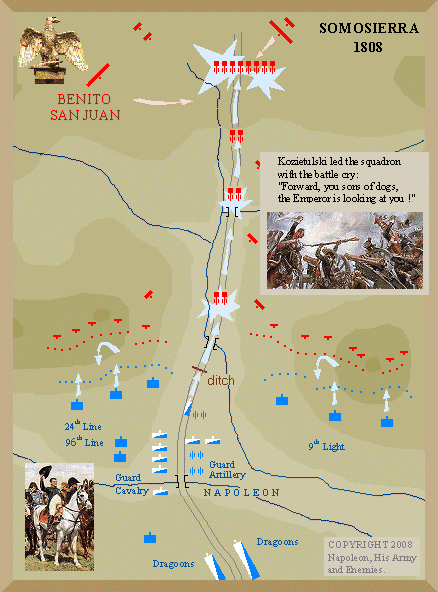
A small battle renowned for the heroic charge of Polish lancers against strong
defensive positions. During his advance on Madrid, Napoleon Bonaparte found
his progress blocked by General San Juan with 9000 troops and 16 cannon.
An initial move against the Spaniards failed to clear them and so the emperor,
impatient at the delay, ordered the Polish cavalry against the strong defensive
position. The assault was a bloody one with two-thirds of the horsemen injured
or killed, but the defenders were shaken by the incident and a combined infantry-cavalry
attack threw them backwards. Bonaparte was so impressed with the Polish horsemen
he immediately promoted them from the Young Guard to the Old Guard and ordered
the entire Guard to present arms to the Poles as they rode by.
Sorauren
28 July, 1813
30 July, 1813
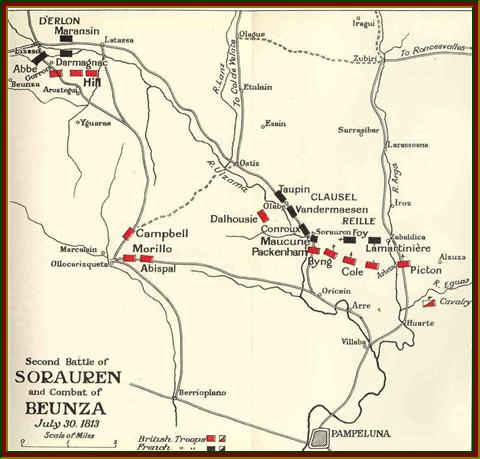 Having arrived in the vicinity of Pamplona after an exhausting 5-day march following the action at Maya, the South Lancashire's took up a post on the south side of the Oricain mountain, west of the Ulzama River and Sorauren village and there held the extreme left end of the British line, tying Wellington loosely in with Hill, who remained 6-7 miles north-west at Lizaso with another British force, blocking D'Erlon. Soult, having been checked at 1st Sorauren on the 28th and running out of time and supplies, determined to retreat and started the process of disengaging on the night of the 29th. Wellington, meanwhile, resolved to attack. As part of his orders, he directed Lord Dalhousie to send the 7th Division forward from its position on the left, in order to turn the French right flank and hinder its retreat. The 30th of July, 1813 began for the men of the 82nd with the sound of battle ringing in their ears when they were awakened by the fire of musketry close to their camp. They quickly mustered and were wheeled into line, but it turned out that only the piquet's were actually engaged.
Having arrived in the vicinity of Pamplona after an exhausting 5-day march following the action at Maya, the South Lancashire's took up a post on the south side of the Oricain mountain, west of the Ulzama River and Sorauren village and there held the extreme left end of the British line, tying Wellington loosely in with Hill, who remained 6-7 miles north-west at Lizaso with another British force, blocking D'Erlon. Soult, having been checked at 1st Sorauren on the 28th and running out of time and supplies, determined to retreat and started the process of disengaging on the night of the 29th. Wellington, meanwhile, resolved to attack. As part of his orders, he directed Lord Dalhousie to send the 7th Division forward from its position on the left, in order to turn the French right flank and hinder its retreat. The 30th of July, 1813 began for the men of the 82nd with the sound of battle ringing in their ears when they were awakened by the fire of musketry close to their camp. They quickly mustered and were wheeled into line, but it turned out that only the piquet's were actually engaged.
Having ascertained the danger to his open flank, Marshal Soult had directed Gen. Vandermaesen to deploy several French battalions to the crest of the mountain across the valley from the 7th Division: a position important so as to cover the retreat of the French army towards Olague. Against these strong French positions Dalhousie set his Brigades in motion. First to go forward was Inglis's Brigade, including the 82nd. After crossing the shallow creek between the two positions, the brigade went forward up the steep and well-wooded slope. The regiments marched side by side in line and not column, to give a broader front; their positions from left to right were the 68th, Chasseurs Brittanique's, 82nd and 51st. The 82nd and Chasseurs advanced against the main French position, which was formed and ready to receive them.
The French let the regiment come in close and then poured a heavy volley into the attackers. It was immediately answered with a volley from the 82nd. The 51st and 68th then poured in volleys. Then, with the Chasseurs Brittanique delivering a rolling musketry, the bugles and drums sounded, the entire brigade gave three resounding cheers and the men came forward at the 'pas de charge'. In a few minutes, during which George Wood received a musket-ball in his shoulder, the crest was carried by the British. Soon after, Inglis deployed his brigade in skirmishing order and drove the reeling French battalions down the opposite side of the height to where the enemy were retreating along the Ulzama River road.
Upon arriving at the bottom of the far side of the mountain, the 82nd and its brigade were joined by the rest of the 7th Division, opening up a harsh musketry on the retreating French columns across the Ulzama River and driving them along the road and up into the hills opposite. Following the west side of the Ulzama, the Division then pursued the French north until it came to a halt and made camp opposite the town of Ostiz. In a dispatch to Lord Bathurst dated the 1st of August, Wellington applauds the conduct of 7th Division: "The attack made by Lieut. Gen. The Earl of Dalhousie was admirably conducted by his Lordship, and executed by Maj. Gen Inglis and the troops composing his brigade…".
As the day of battle drew to a close, the 7th Division was ordered by Wellington to move north-west to Lizaso, to link up there with Lt. Gen Hill's force. With dawn on the 31st, the 82nd and its Division were in motion and by 2pm had arrived at Lizaso. Pushing through the town, the 7th Division caught up with Hill at Venta de Urroz near the foot of the Donna Maria pass. Here Hill was already in action, attacking the rearguard of the retreating French army, formed by Gen. Abbe's Division. Inglis's Brigade, being the first to arrive, immediately joined the assault. It was a steep climb and a tough fight, but the French after a stiff resistance retreated up the pass. A fog, common in those mountains, rolled in at 5pm and allowed the French to escape further fighting. The 7th Division was left alone to follow the retreating French through the Donna Maria, while Hill took his army north-east over a separate route.
Dawn on Aug. 1 showed the French army having cleared the pass the previous evening and encamped about the town of Santesteban for a few hours. At 2:30am, long before daybreak, Marshal Soult continued his retreat, following the rough road down the gorge of the Bidassoa towards Sumbilla and Echelar. The 7th Division followed at a leisurely pace. It was headed off by the Gen. Cole and the 4th Division at Santesteban, and so did not take part in the combats that occurred as the French army scrambled down the gorge to safety. This was the conclusion of the Battles of the Pyrenees: a complete failure for Soult and his army and a hard blow to the morale of the French.
In total, when Marshal Soult counterattacked through the Pyrenees, Sir Arthur Wellesley collected a sizeable force, some 24,000 men, and moved to stop him at Sorauren. Soult, who had 60,000 troops at his disposal, launched an uphill assault with just under half of them and was met by determined British resistance. The fighting at the top of the ridge was bitter and bloody, but the defenders held the French off. British reinforcements arrived and Wellesley sent them to assault the enemy right flank. More fresh units reached the field and soon Soult was ordering a withdrawal. French suffered 4000 casualties, while Wellesley's army lost 2600 men.
Two smaller battles occurred two days later as the French tried to get between Wellesley's army and the troops surrounding San Sebastian. At Tolosa, General Hill fended one attempt off and a night retreat, again near Sorauren, cost the French 3500 casualties. With his momentum dead in the water, Soult withdrew into France to prepare his defences against the imminent British offensive.
 |
Talavera
27-28 July, 1809 (Sharpe's Eagle)
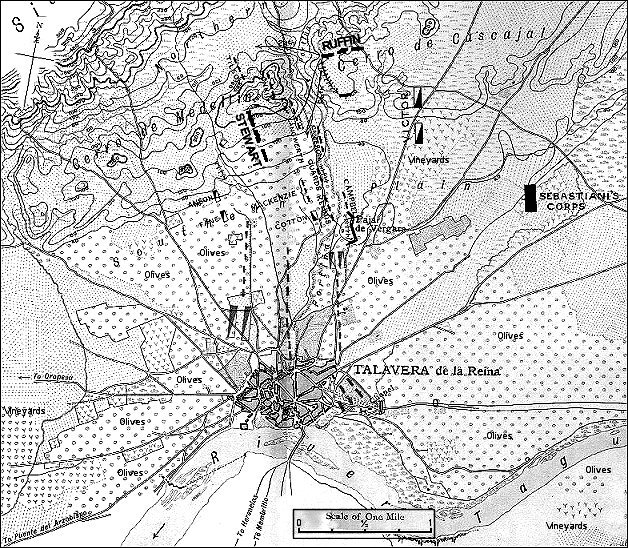
The soon-to-be Duke of Wellington had a sizeable force of some 55,000 men and 60 cannons with which to oppose King Joseph Bonaparte, Marshal Jourdan and Marshal Victor's 46,000 troops and 80 guns. Unfortunately, for Wellington, his force's number included 35,000 Spaniards under General Cuesta, with whom co-operation was difficult.
Arrayed on the left of the positions behind the Alberche River, the British got an indication of the quality of their allies when the Spaniards panicked and fled after their own sentries fired a volley at patrolling French cavalry. Later that night an assault by General Ruffin almost forced the British lines and only a counterattack sent the French packing. At 5am the next day, the French commanders launched three columns at the Allied lines, but each was beaten off within two hours. In extremely high temperatures the French continued to batter the defenders, but the volley fire halted them each time.
A final attempt was made by Joseph and Jourdan to turn the flanks but was driven off by artillery fire. Following this failure they decided to withdraw. The British lost almost 5500 men, the Spaniards just over 1000 and the French some 7200. Many men wounded in the battle died in a grassfire that spread across the field.
Siege of Tarifa
29 December 1811 to 5 January 1812
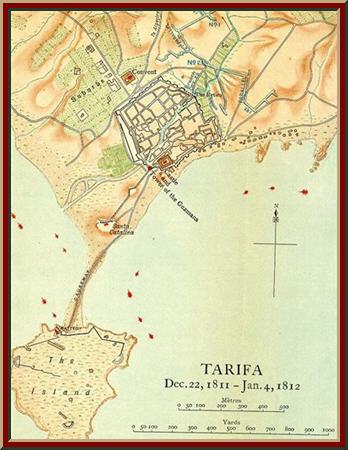 The French army of occupation in Andalusia had for some time been irritated by the small Spanish army of General Ballesteros, who whenever confronted was able to retire his army under the walls of Gibraltar or into the fortified town of Tarifa. Because he could not hope to reduce Gibraltar, Marshal Soult decided to attempt a siege of Tarifa, which if successful would much limit the operations of the Spanish. Besides the 2,000 men of the Spanish garrison in the town, Tarifa had also a substantial British force within it walls, consisting of a detachment of the 82nd Regiment, the 2/47th, 2/87th, the light company of the 11th, a detachment of the 2nd Hussars KGL (King's German Legion), some Royal Artillery and several companies of the 95th Rifles. The British force, therefore, mustered 67 officers and 1,707 men all told. The British contingent was commanded by Colonel Skerret of the 2/47th. The fortress itself, on the whole though, was poorly maintained and out of date and therefore eminently capturable.
The French army of occupation in Andalusia had for some time been irritated by the small Spanish army of General Ballesteros, who whenever confronted was able to retire his army under the walls of Gibraltar or into the fortified town of Tarifa. Because he could not hope to reduce Gibraltar, Marshal Soult decided to attempt a siege of Tarifa, which if successful would much limit the operations of the Spanish. Besides the 2,000 men of the Spanish garrison in the town, Tarifa had also a substantial British force within it walls, consisting of a detachment of the 82nd Regiment, the 2/47th, 2/87th, the light company of the 11th, a detachment of the 2nd Hussars KGL (King's German Legion), some Royal Artillery and several companies of the 95th Rifles. The British force, therefore, mustered 67 officers and 1,707 men all told. The British contingent was commanded by Colonel Skerret of the 2/47th. The fortress itself, on the whole though, was poorly maintained and out of date and therefore eminently capturable.
On Dec. 8, 1811, 12,500 troops under Marshal Soult set off from Cadiz, reaching Tarifa on the 20th. After a few days preparation, the French artillery opened up on the 29th of December, concentrating upon the northern and eastern sides of the town, which were most vulnerable. It did not take long for the walls of the old medieval fortress to crumble and in several hours there was a practicable breach on the east side. At this point Col. Skerret, alarmed at the state of affairs, made ready to leave Tarifa; however, he was dissuaded by Major King of the 82nd and Captain Smith of the Engineers. To seal the decision, Lt. General Graham at Gibraltar ordered the British transports away from Tarifa. There was no going home now.
Gen. Laval now took command of the siege from Soult. By Dec. 30, the breach was over 60 feet wide, but a call by the French to surrender was turned down by the garrison. The next day, the French attempted to storm the town but due to a heavy rain and a determined defense, it failed, leaving 207 casualties before the walls. After this, there were no more attempts on the fortress, as incessant rain and the failure of the assault on the wall served to break the French morale. On January 5, 1812, the French army moved off, having suffered over 500 casualties and leaving behind a number of guns. The garrison suffered little in comparison, tallying 70 casualties, including 46 British.
Battle of Trafalgar
21 October 1805
In July 1805 Napoleon Bonaparte secretly left Milan and hurried to Boulogne,
where his Grande Armée waited in camp to cross the Channel and invade England.
Napoleon only needed Admiral Villeneuve to bring the French and Spanish Fleets
from South Western Spain into the Channel to enable the invasion to take place.
The First Sea Lord appointed Admiral Lord Nelson Commander in Chief of the British
Fleet assembling to attack the French and Spanish ships. Nelson selected His
Majesty’s Ship Victory as his flagship and sailed south towards Gibraltar. As
the British ships intended for the Fleet were made ready they sailed south to
join Nelson.
In October 1805 Villeneuve was still in harbour in Cadiz. He received a stinging
rebuke from Napoleon accusing him of cowardice and Villeneuve steeled himself
to leave harbour and make for the Channel. He was encouraged in his resolve
by the belief that there was no strong British Fleet nearby and that Nelson
was still in England. Other than picket frigates watching the harbour Nelson
kept his main fleet well out to sea.
On 19th October 1805 at 9am HMS Mars relayed the signal received from the frigates
that the Franco-Spanish Fleet was leaving Cadiz in line of battle.
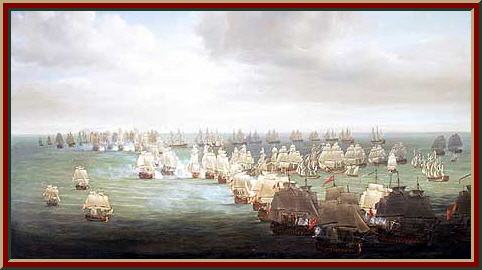 At dawn on 21st October 1805, with a light wind from the West, Nelson signalled
his fleet to begin the attack. The British captains understood fully what was
required of them. Nelson had explained his tactics over the previous weeks until
every ship knew her role.
At dawn on 21st October 1805, with a light wind from the West, Nelson signalled
his fleet to begin the attack. The British captains understood fully what was
required of them. Nelson had explained his tactics over the previous weeks until
every ship knew her role.
At 6.40am the British Fleet beat to quarters and the ships cleared for action:
cooking fires thrown overboard, the movable bulkwarks removed, the decks sanded
and ammunition carried to each gun. The gun crews took their positions.
The French and Spanish Fleets were sailing in line ahead in an arc like formation.
The British Fleet attacked in two squadrons in line ahead; the Windward Squadron
led by Nelson and the Leeward headed by Collingwood in Royal Sovereign; the
ships of the Fleet divided between the two squadrons. Nelson aimed to cut the
Franco-Spanish Fleet at a point one third along the line with Collingwood attacking
the rear section. In the light wind the van of the Franco-Spanish Fleet would
be unable to turn back and take part in the battle until too late to help their
comrades.
The two British squadrons, led by the Flagships, sailed towards the Franco-Spanish
line, Collingwood’s Royal Sovereign significantly ahead of Victory. Anxious
that the admiral should not be excessively exposed to enemy fire, the captain
of Temeraire attempted to overtake Victory, but was ordered back into line by
Nelson.
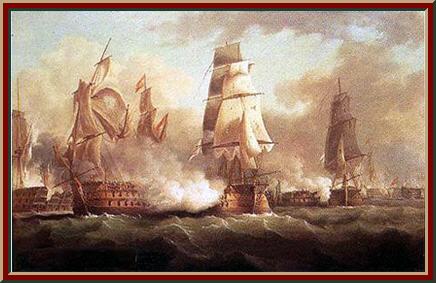 The
first broadside was fired by the French ship Fougueux into Royal Sovereign as
Collingwood burst through the Franco-Spanish line. Royal Sovereign held her
fire until she sailed past the stern of the Spanish Flagship, Santa Anna. Royal
Sovereign raked Santa Anna with double shotted fire, a broadside that is said
to have disabled 400 of her crew and 14 guns.
The
first broadside was fired by the French ship Fougueux into Royal Sovereign as
Collingwood burst through the Franco-Spanish line. Royal Sovereign held her
fire until she sailed past the stern of the Spanish Flagship, Santa Anna. Royal
Sovereign raked Santa Anna with double shotted fire, a broadside that is said
to have disabled 400 of her crew and 14 guns.
Royal Sovereign swung round onto Santa Anna’s beam and the two ships exchanged
broadsides. The ships following in the Franco-Spanish line joined in attacking
Collingwood: Fougueux, San Leandro, San Justo and Indomptable, until driven
off by the rest of the Leeward Squadron as they came up. Royal Sovereign forced
Santa Anna to surrender when both ships were little more than wrecks.
Victory led the Windward Squadron towards a point in the line between Redoubtable
and Bucentaure. The Franco-Spanish Fleet at this point was too crowded for there
to be a way through and the Victory simply rammed the Redoubtable, firing one
broadside into her and others into the French Flagship Bucentaure and the Spanish
Flagship Santissima Trinidad. The British ship Temeraire flanked Redoubtable
on the far side and a further French ship linked to Temeraire, all firing broadsides
at point blank range. The following ships of Nelson’s squadron, as they came
up, engaged the other ships in the centre of the line. The leading Franco-Spanish
squadron continued on its course away from the battle until peremptorily ordered
to return by Villeneuve.
During the fight with Redoubtable the soldiers and sailors in the French rigging
fired at men exposed on the Victory’s decks. A musket shot hit Nelson, knocking
him to the deck and breaking his back. The admiral was carried below to the
midshipmen’s berth, where he constantly asked after the progress of the battle.
Eventually Hardy was able to tell him before he died that the Fleet had taken
15 of the enemy’s ships. Nelson knew he had won.
The battle reached its climax in the hour after Nelson’s injury. Neptune, Leviathan
and Conqueror, as they came up, battered Villeneuve’s Flagship Bucentaure into
submission and took the surrender of the French admiral. Temeraire while fighting
the Redoubtable fired a crippling broadside into the Fougueux. Leviathan engaged
the San Augustino bringing down her masts and boarding her.
In the Leeward Squadron Belleisle was stricken into a wreck by Achille and the
French Neptune until relieved by the British Swiftsure. Achille was then battered
by broadsides until fires reached her magazine and she blew up.
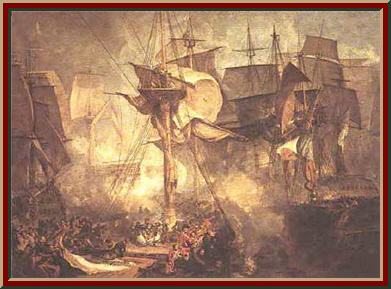 All
the French and Spanish ships of that part of the line were destroyed, captured
or fled: of the 19 ships, 11 were captured or burnt while 8 fled to leeward.
Many of these ships fought hard. Argonauta and Bahama lost 400 of their crew
each. San Juan Nepomuceno lost 350. When she blew up Achille had lost all of
her officers other than a single midshipman. The resistance of the French ship
Redoutable was was quite in keeping with her name.
All
the French and Spanish ships of that part of the line were destroyed, captured
or fled: of the 19 ships, 11 were captured or burnt while 8 fled to leeward.
Many of these ships fought hard. Argonauta and Bahama lost 400 of their crew
each. San Juan Nepomuceno lost 350. When she blew up Achille had lost all of
her officers other than a single midshipman. The resistance of the French ship
Redoutable was was quite in keeping with her name.
The Franco-Spanish van commanded by Admiral Dumanoir passed the battle, firing
broadsides indiscriminately into comrade and enemy, and returned to Cadiz. Following
the battle a storm blew up wrecking many of the ships damaged in the action.
Of those captured only 4 survived to be brought into Gibraltar. British casualties
were 1,587. The French and Spanish casualties were never revealed but are thought
to have been around 16,000.
The consequences of the battle were far reaching. Napoleon’s plan to invade
Britain was thwarted. He broke up the camp at Boulogne and marched to Austria
where he won the great victory of Austerlitz against the Austrians and Russians.
Trafalgar ensured that Britain’s dominance at sea remained unchallenged for
the rest of the 10 years of war against France and continued worldwide for a
further 120 years.
 |
The combat of Usagre (25 May 1811) was a minor cavalry battle during Marshal Soult's retreat after the battle of Albuera. Having failed in his attempt to come to the aid of the siege of Badajoz, Soult had retreated back towards Andalusia, with the Allied cavalry following close behind. What Soult was unable to discover was if any Allied infantry was following close behind, and so when he reached Llerena, Soult decided to send Latour-Maubourg's cavalry back to attack the Allied advance guard, in the hope that the French cavalry would be able to push the Allied cavalry back onto any infantry. Latour-Maubourg took ten regiments of cavalry from the brigades of Bron, Bouvier de Éclats, Vinot and Briche, giving him a force 3,000 strong. This strong French force was able to push back the most advanced Allied cavalry, some Spanish horse under Penne Villemur, from Villa Garcia back to Usegre, where Latour-Maubourg found the main force of Allied cavalry.
The Allied were significantly outnumbered. General Lumley had 2,200 men, made up of three regiments of British cavalry (900 strong), four small Portuguese regiments (about 1,000 strong) and 300 men from Penne Villemur's force. However the Allied did have a very strong position. The town of Usagre was located on the southern side of a stream which runs through a clear ravine. The Allied cavalry was located on the northern bank of the stream, which could be crossed either on the main road bridge, or on a pair of fords, one to each side of the town. Lumley responded to the appearance of the French by sending a detachment across each ford to watch the flanks of Latour-Maubourg's force. When he realised how large the French force was, Lumley pulled those forces back to the north bank, inadvertently revealing the location of the northern ford (on the Allied left or the French right).
Latour-Maubourg was facing with a potentially dangerous situation. The Allied cavalry was clearly present on the far side of the stream, but it was hidden behind the sky-line, and so he had no idea how strong a force he was facing. He decided to launch a two-pronged attack on the Allies. Briche's brigade was sent north, to cross the ford on the French right, with orders to attack the Allied left. Once he was in place, Latour-Maubourg planned to send his main force across the bridge, hopefully trapping the Allies between two forces.
The main weakness in this plan was that the two parts of the French army had no way to communicate with each other. Briche found the ford, but it was strongly held by Otway's Portuguese cavalry, and so Briche was forced to move further north in a futile attempt to find another ford. Unfortunately Briche did not send a messenger back to Latour-Maubourg to inform him of the delay, and so after waiting for over an hour Latour-Maubourg began to cross the bridge.
Lumley waiting until two of the three regiments in Bron's brigade had crossed the bridge, and then launched a full scale attack with the 4th Dragoons, the 3rd Dragoon Guards, Madden's Portuguese and Penne Villemur's Spaniards. The isolated French regiments were almost completely destroyed, suffering 250 killed and wounded and losing 78 prisoners, amongst them the colonel of the French 4th Dragoons. Of his original ten regiments, only six were now with Latour-Maubourg.
Lumley resisted the temptation to attack Latour-Maubourg in Usagre, recognising that the French had just as strong a defensive position as the Allies had enjoyed. Usagre became the front line for the next month, with the town remaining in French hands, while Soult made Llerena his base. Lumley's victory at Usagre prevented Soult from discovering that the Allied infantry was in fact some way behind the cavalry, having needed nearly a week to recover from their victory at Albuera.
 |
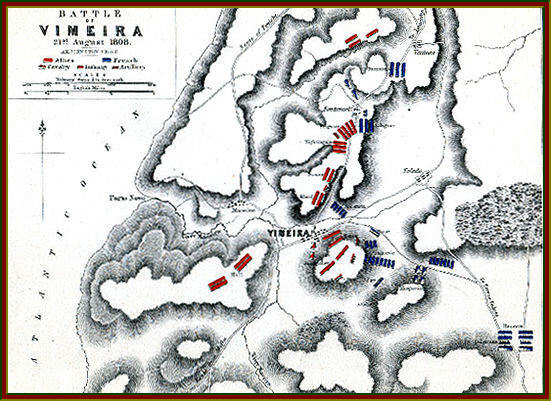
The battle of Vimiero was the decisive battle of the first British expedition to Portugal during the Peninsular War. The Spanish revolt had isolated General Junot's French army in Portugal, and given the British a chance to use their command of the sea to strike a meaningful blow against the French. Accordingly an army 10,000 strong under Sir Arthur Wellesley had been dispatched from Ireland, landing at Mondago Bay, to the north of Lisbon, at the start of August 1808. After spending a week organising his forces, Wellesley began his march south on 10 August. His first major clash with the French came on 17 August, at Rolica, where the British forced a French army to abandon a strong defensive position. From Rolica, Wellesley's army then moved back to the coast, to Porto Novo, at the mouth of the Maceira River, where reinforcements were expected. The Allied army took up a position on the heights of Vimiero.
Soon after Wellesley' expedition had left Ireland it had become apparent that Junot had far more men then had been believed. According another 10,000 men were added to the expedition, and overall command was given to Sir Hew Dalrymple, with Lieutenant General Sir Harry Burrard as second in command and Sir John Moore third in command, pushing Wellesley back to fourth. Wellesley had only learnt of these changes when he reached Spain.
Now, on 20 August Lieutenant General Sir Harry Burrard arrived offshore and took over command of the expedition. His first orders were to forbid any further advance towards Lisbon until the rest of the expedition had arrived. Luckily for Wellesley, Burrard then decided to spend another night onboard ship, leaving Wellesley still in charge of the army for one more day.
An even biggest stroke of luck was about to fall into Wellesley's lap. General Junot had reluctantly decided to march north, leaving Lisbon on 15 August at the head of his reserve. By 19 August Junot had been joined by detachments under Generals Loison and Delaborde, giving him a force of around 10,000 infantry and 3,000 cavalry. On 20 August the French were only ten miles from Vimiero.
Wellesley had three big advantages at Vimiero. First, he had a strong position, on the heights of Vimiero. Second, he now outnumbered Junot, having just under 17,000 British and 2,000 Portuguese troops. Third, Junot had a very low opinion of the British army. He therefore decided to launch a frontal assault on the British lines with his main force, while sending a second column to attack the British left. Vimiero would thus be the first of many times during the Peninsular War when a British line would face a French column.
The first of the frontal assaults began at around nine on the morning of 21 August, and was repulsed with ease by a combination of British artillery and musket fire. Junot responded with a second attack at the same point, which was also repulsed, this time with the help of shrapnel shells. A third and final attack was launched, and reached the village of Vimiero before being repulsed.
Only now, after the failure of the main attack, did Junot's flanking attack on the British left finally take place. Even then only half of the original force took part, the brigade under General Brennier having disappeared off to the north in an attempt to find a away around a ravine. The remaining brigade, under General Solignac, had crossed that ravine and formed up ready to launch an attack up the hill at what appeared to be a thin line of British skirmishers.
They were actually facing seven battalions, hidden behind the crest of the hill. As the French column reached the top of the hill they came under fire from 3,300 men arranged in a long thin (two man deep) line. The French column broke and fled, and was only saved from further destruction by the late arrival of Brennier. His force launched a counterattack, which stopped the British pursuit before itself being beaten off. Brennier himself was captured.
By 12.30 the French were retreating all across the battlefield, but Wellesley was not given a chance to exploit this chance of a crushing victory. General Burrard had finally come ashore. Having left Wellesley in charge during the French attack, he then refused to authorise any further action, and Junot was able to get away with most of his army intact. Even so, French casualties were high. At least 2,000 of Junot's original 13,000 men had been lost at Vimiero, while the British had only lost 720 men, amongst them 135 dead.
On the day after the battle General Dalrymple finally arrived in Portugal to take command of his army. He was just as cautious as Burrard, and made it clear that he did not approve of the risks Wellesley had taken, even though they had resulted in a clear victory. On 22 August a French delegation appeared at the British camp, and negotiations began. Eventually Dalrymple and Burrard agreed to the Convention of Cintra, under which it was agreed that the Royal Navy would evacuate the French from Portugal, complete with all of their military equipment. Wellesley was involved in the negotiations, and as fourth in command had no choice but to sign it, but he made it clear that he disagreed with the terms of the convention. So did the British public who were outraged. Dalrymple, Burrard and Wellesley were all recalled to Britain, to take part in a court of enquiry into the terms of the convention, and of the three men only Wellesley would survive with his reputation and his career intact.
Vitoria
21 June, 1813 (Sharpe's Honour)
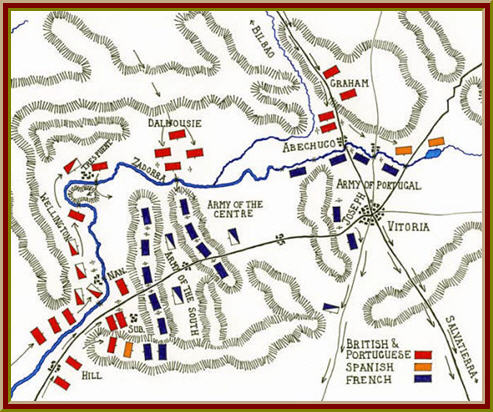
Vitoria was the battle that broke the back of the French occupation of Spain and led to common Allied soldiers becoming wealthy men overnight, as they looted a baggage train containing some 5.5 million francs worth of treasure.
In the lead up to Vitoria, the Duke of Wellington split his army of some 70,000 men in two and sent the majority of them (40,000 under General Graham) on a series of hook marches that would force the French to continually look at their defensive flanks. The remaining men would shepherd King Joseph and Marshal Jourdan's force of 50,000 towards their own border.
At Vitoria, the sides collided and a series of French errors - most crucially not guarding a key bridge at Tres Puentes - allowed Wellington to cross the major Zadorra River with several divisions. From there the British began flank attacks on the French defenders, pushing them slowly back towards the village of Vitoria. The French fought with great courage in an attempt to allow the massive baggage trains enough breathing space to get a head start on their journey back to France.
The French line of communications now came under threat from Graham's late-arriving troops, who seized heights overlooking a crucial position at the village of Gamarra Mayor and quickly occupied the hamlet itself. Desperate to win back Gamarra Mayor, the French launched several ferocious counterattacks, but these were all beaten off.
Continuing his advance, Graham found himself unable to cross the Zadorra in the face of exceptionally well-positioned French troops, who took a step backwards only after the battle was won by Wellington, finally breaking their army's central position. The British lost some 5000 men, while 7500 Frenchmen became casualties. Fleeing to the east, the French soldiers officially abandoned the treasure wagons and, while occasionally stopping to help British troops loot them, ran to avoid capture. The Allied pursuit was ruined by the wealth on offer to poorly-paid soldiers and a furious Wellington found himself with only some 250,000 francs to bolster his war chest.
 |
 |
 |
 |
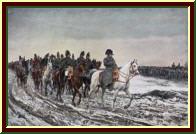 |
||||||
 |
 |
 |
 |
 |
||